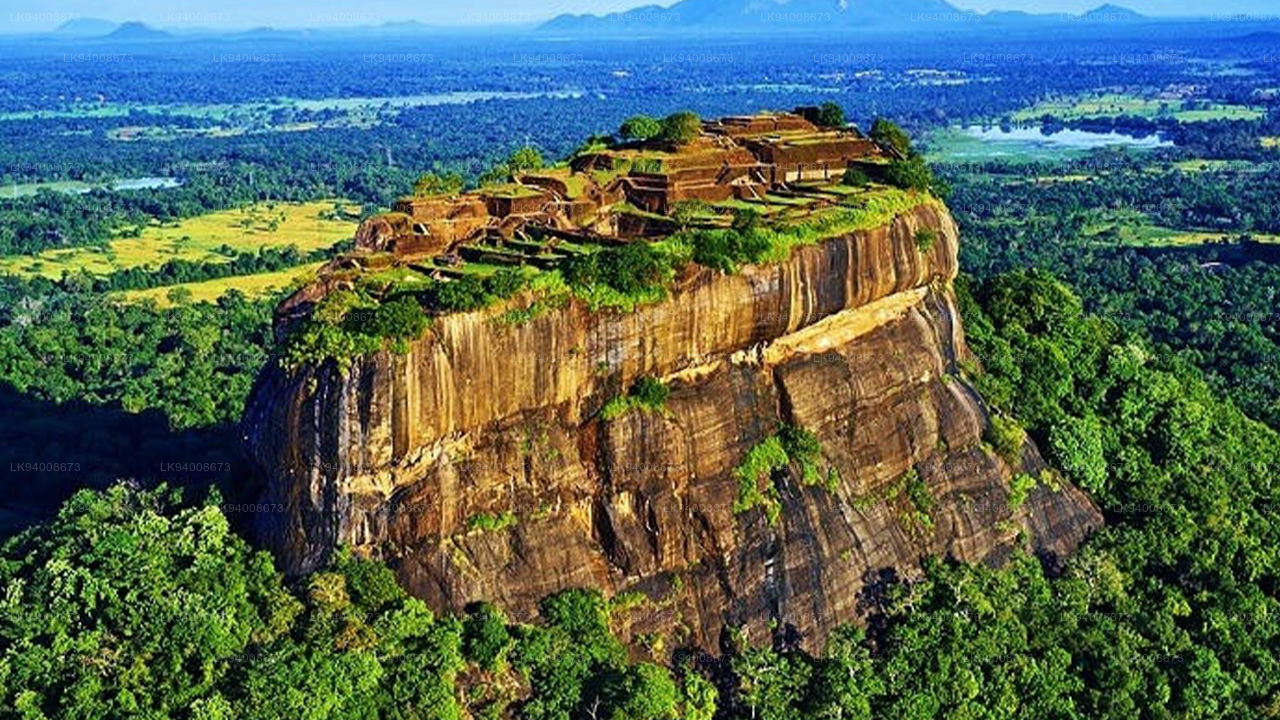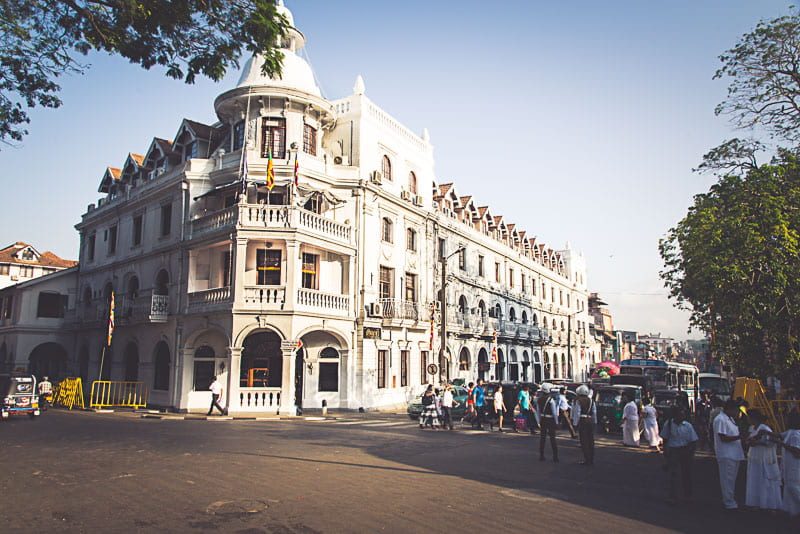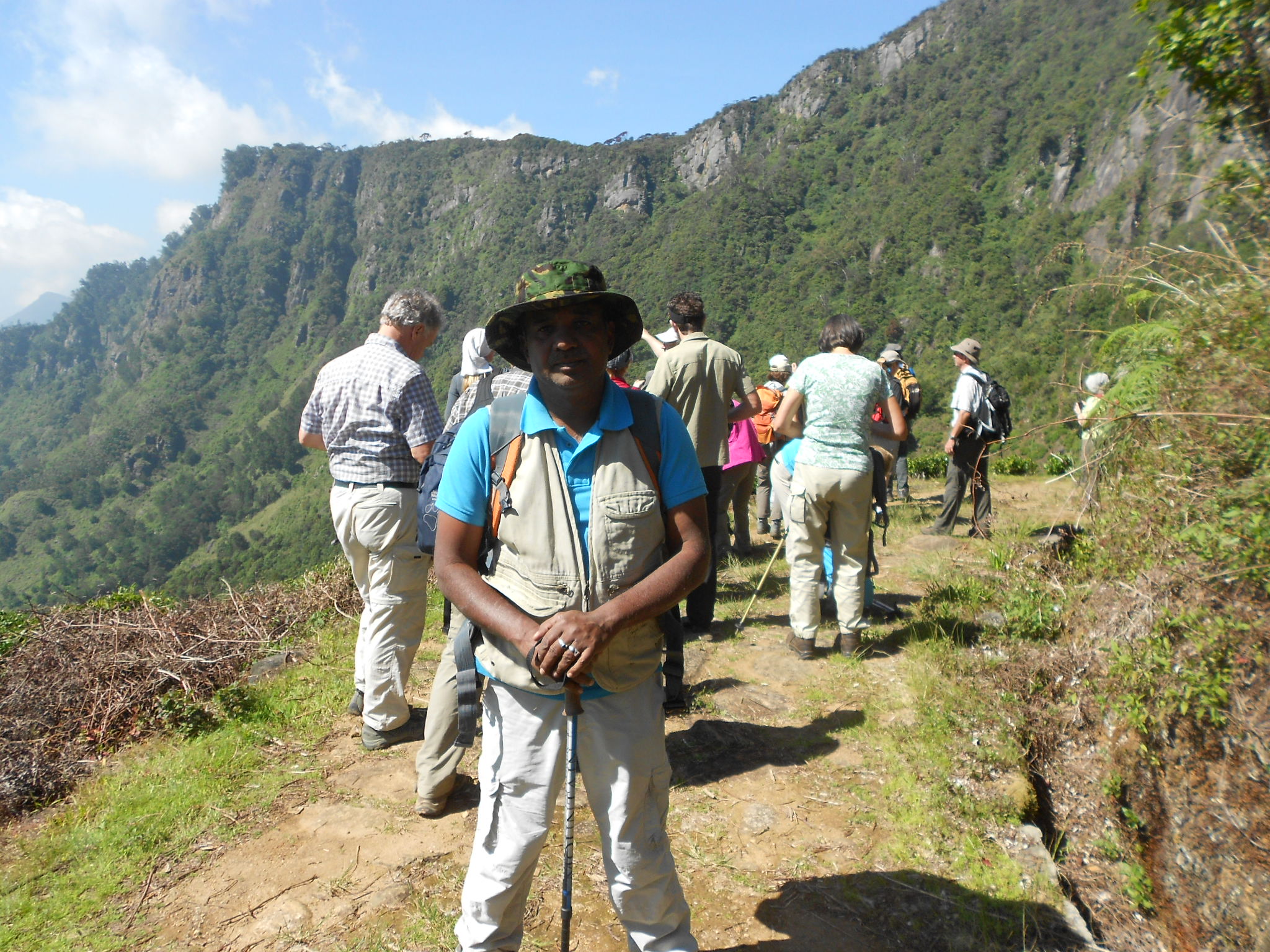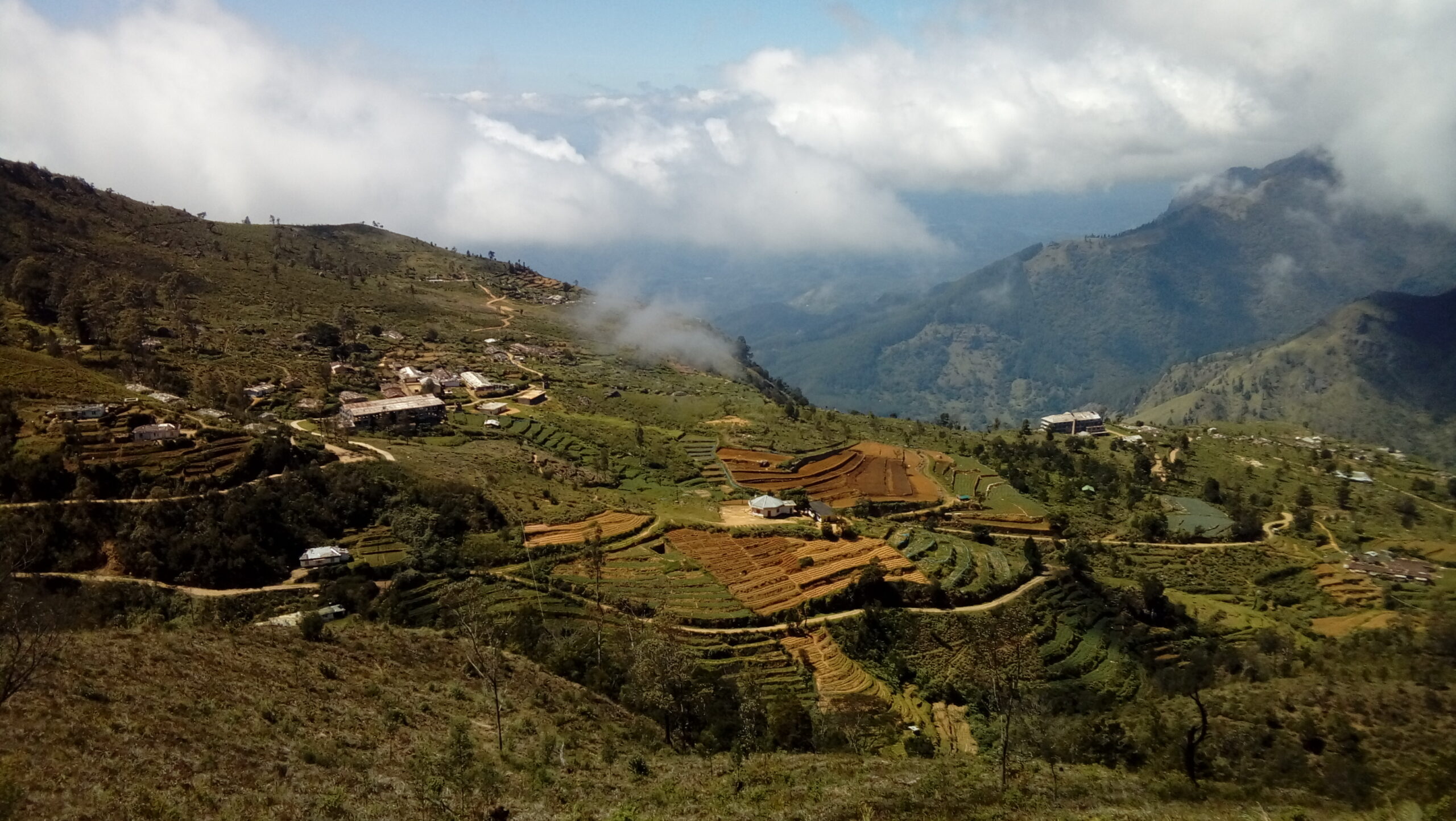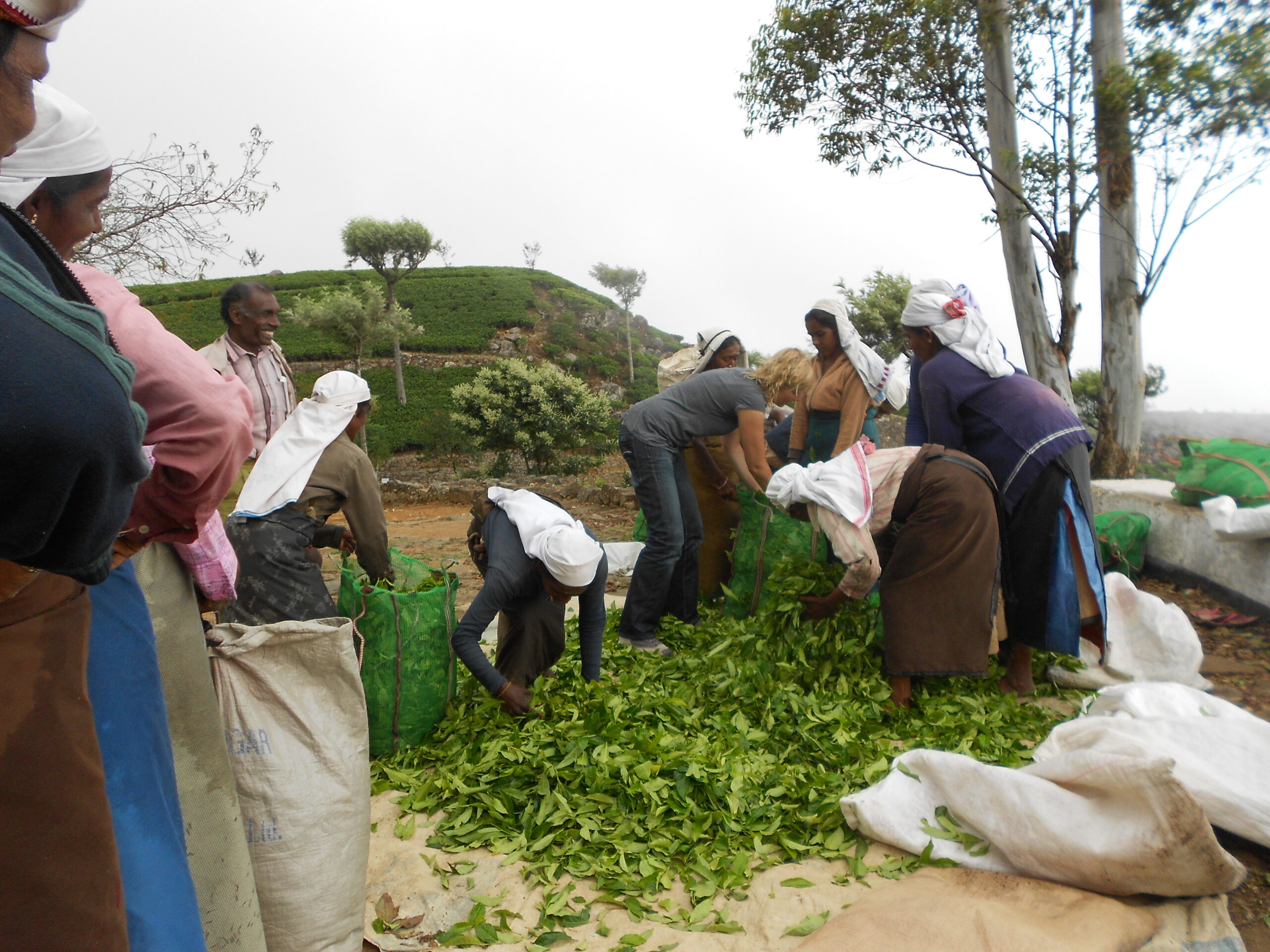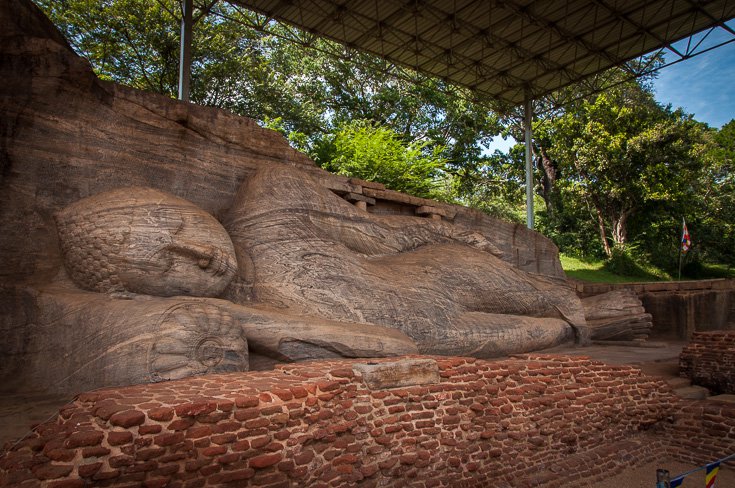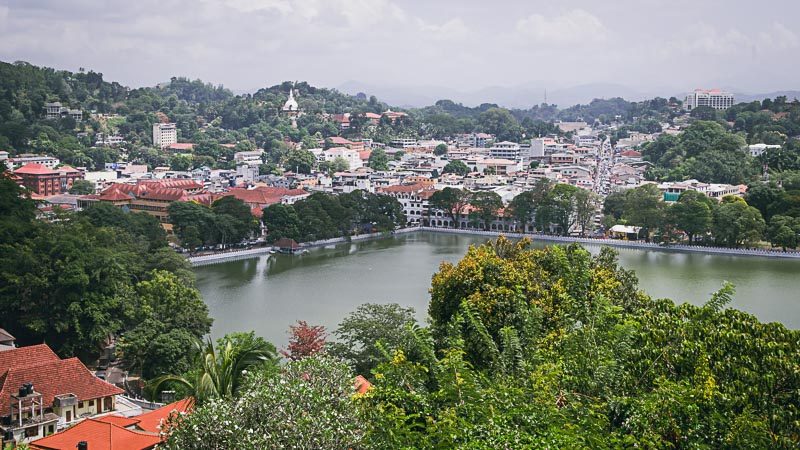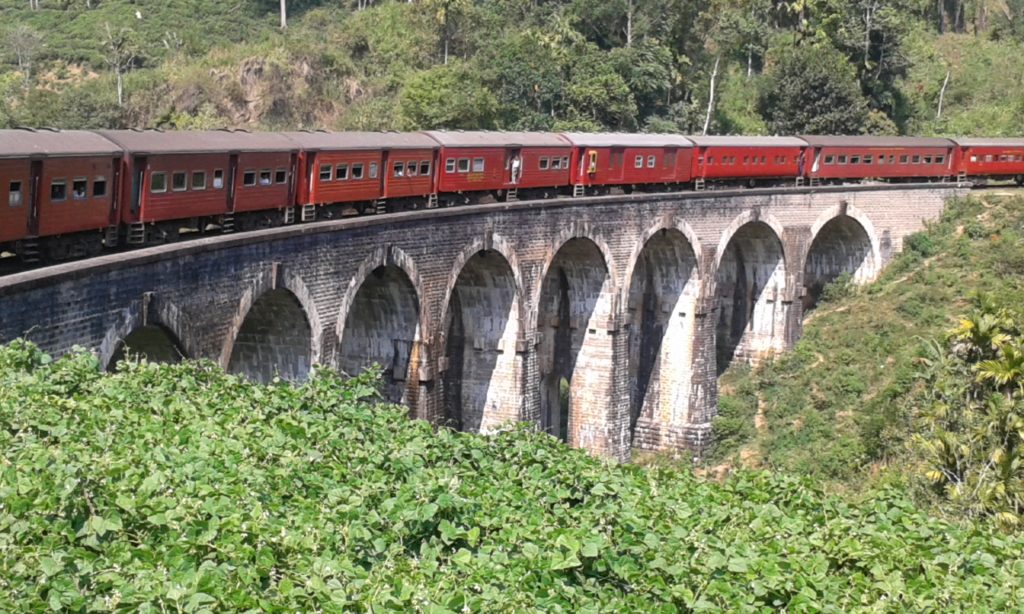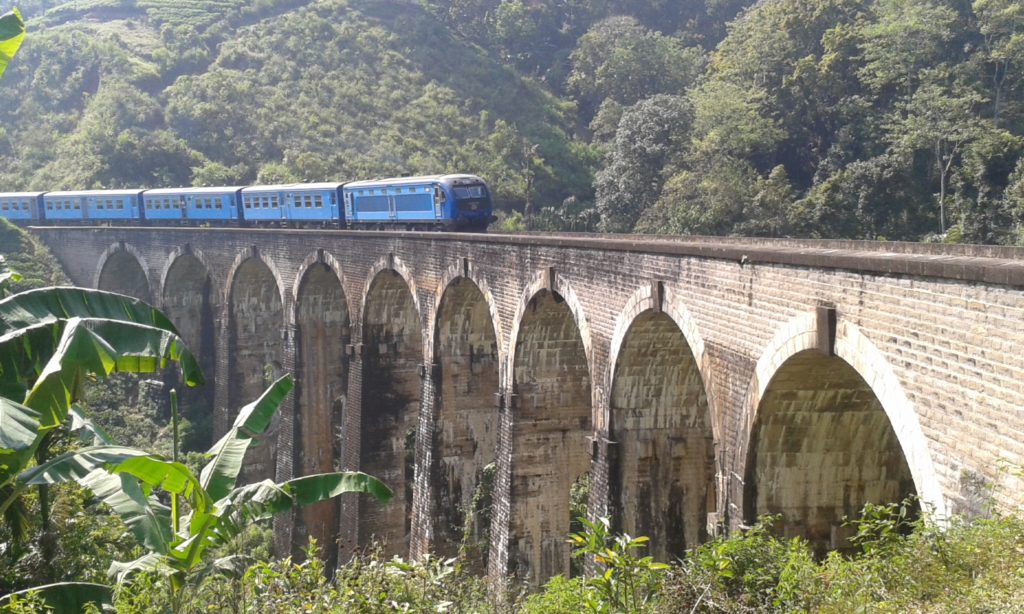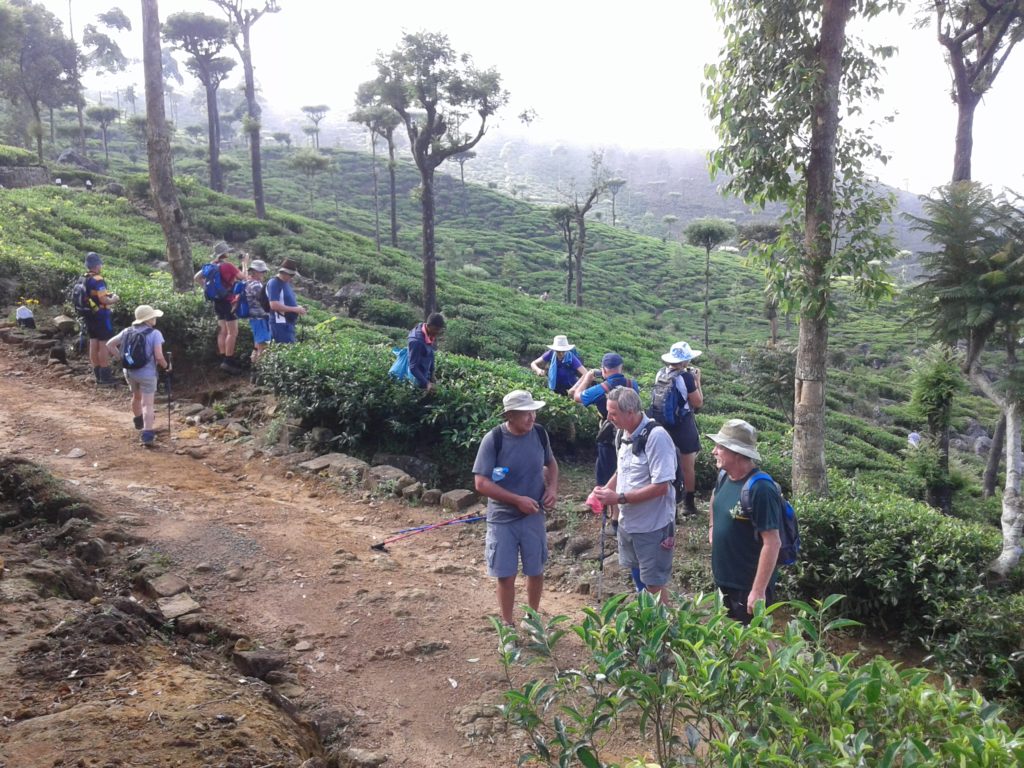Trekking Tours in Sri Lanka
Pekoe trails Tour 1
Trek the best sections of Pekoe Trail that winds through enchanting hill country with culture of Sri lanka,
6 Days Pekoe Trail Trekking
Day 1 – Arrive Colombo. Group transfer to Sigiriya
5 to 6 hours.
You will be met at the airport and driven to Sigiriya, the 5th century rock fortress of Sigiriya. A World Heritage Site is now one of Sri Lanka’s major attractions rising two hundred meters from the jungle floor. At the rocks base are extensive gardens, ramparts and a moat. During our visit to this unique complex, we will see water gardens, ancient frescoes, the stone mirror wall and the lion platform. For the fittest, a climb up to the summit would be an achievement!
Dinner and overnight in Sigiriya Fresco Water Villa Hotel Or Similar,
Day 2 – Sightseeing in Polonnaruwa. And Sigiriya
After breakfast at the hotel, we will do some sightseeing in Polonnaruwa, which was the 2nd capital city of Sri Lanka, built in the 11th and 12th centuries AD and which is a World Heritage Site. You can see the ruins of the Royal Palace, the Gal Viharaya – where 4 splendid statues of the Buddha in “Upright”, “Sedentary” and “Recumbent” postures carved out of rock. We would also see the Audience Hall, the Lotus Bath, king Parakramabahu’s statue and the Parakrama Samudraya Lake built by King Parakramabahu the great. There are monuments of famous places of worship such as the the Watadage, the Galpotha, the Kiri Vehera and the remains of a former Tooth Relic.
Dinner and overnight in: Fresco Water Villa Hotel Or Similar, Kandy
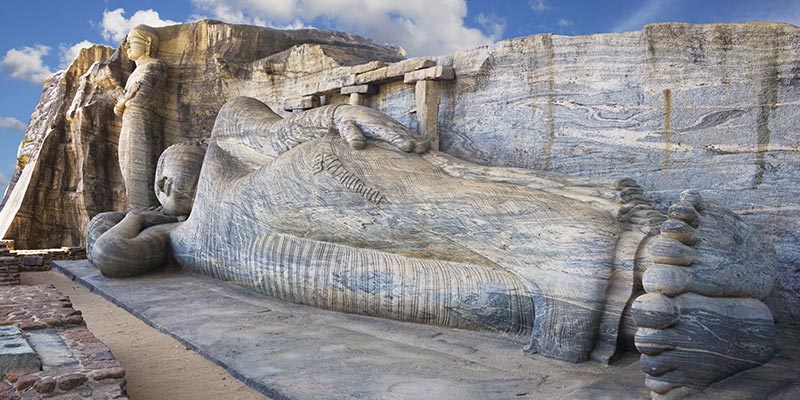
Day 3 – Sacred City of Kandy Dambulla cave temple
Your trip to Kandy will not be completed without a tour around the charming lake of Kandy. It is another fascinating attraction
After breakfast at the hotel, we will visit Dambulla is a part of the Cultural Triangle declared by UNESCO, there are over 80 caves in the surrounding area and some of them have been used by the monks as meditation locations. Major attractions are spread over 5 caves which contain the statues and the paintings. Since its founding in the first century BC
After the Cave temple drive to Kandy, Kandy is the last Royal Kingdom of Sri Lanka with picturesque landscape surrounded by beautiful mountains located in the central part of the island positioned 1,600 feet above the MSL- Mean Sea Level. Kandy Sri Lanka is well known with the Sacred Tooth relic Temple which is most venerated Buddhist Temple and The Royal Botanic Gardens with more than 4,000 labeled species of flora
After lunch in Kandy, visit the sacred Temple of the Tooth Relic and followed by a Kandyan dance program. Overnight in kandy

Day 4 – Sacred City of Kandy Dambulla cave temple
Visit The Royal Botanic Gardens
Day 5 – Start Stage 1 from Hanthana to Galaha. Transfer through Galaha and trek to Deltota – Stage 2.
Time trekking: 6 hours, distance: 11 miles, total ascent: 569m, total descent: 368m.
This is the start of your Pekoe Trail trek and you begin at the Ceylon Tea Museum on the Hanthana Estate, just south of Kandy. If open it is worth visiting. From here you climb upwards through small tea estates to the ridge line and, as you reach the top, you are greeted with sublime views of Kandy and the valley below. To the right of you lies the Katusu Konda also known as the ‘Lizard’s Back’, a steep narrow jagged mountain that look’s akin to a lizard’s spiny backbone. Today’s walking is on a mixture of small tracks and paths, winding through villages where local children come to greet you. There are also fine views of the valleys below. You will stop along the way in one of these villages to enjoy some tasty homemade snacks and a welcome cup of tea. You will then continue on the trail, towards Galaha, until you meet the road head. From here you will be driven through Galaha to reach your second starting point of the day at the Deltota Estate.
Starting off from a Hindu temple you pass a large school, where the noise of the classroom can be heard, before entering the Deltota Estate. A steady climb takes you up through the estate and past a station where the leaves plucked by the tea workers are weighed. Soon after you stop at the house of a local family for lunch. This helps support the community, gives you chance to meet Sri Lankans and to gain a little understanding of their lives. After a traditional meal of curry and rice you continue on to the small, hill country town of Deltota where your first day’s walking on the Pekoe Trail ends. You finish the day by being driven to your accommodation, a short distance from Deltota. Tomorrow you will resume your trek from Deltota.
Overnight: Windloft Retreat Or Similar, Kandy
Day 5 – Trek Stage 2 from Deltota to Loolecondera via Kondagala.
Time trekking: 7 hours, distance: 10 miles, total ascent: 395m, total descent: 319m.
The walk today starts with a steep ascent through dense forest before emerging into open land and some truly sublime views of the verdant, hilly landscape. You climb a series of switchbacks and at each turn there is another glimpse down the valley. This path sees little foot traffic and therefore areas can be overgrown. Continuing you reach the top of the ridge and contour along the valley’s edge to the pristine Loolecondera Estate.
Loolecondera was the was the first commercial tea plantation in Sri Lanka, established in 1867 by a young Scotsman James Taylor who had studied the basics of tea growing in India and went on to introduce the large-scale tea production that we know today. He spent the rest of his life here and the remains of his cottage can still be seen. You will stop at Taylor’s seat, a large granite seat, where it is said that Taylor ‘sat and planned the future of Loolecondera’ whilst gazing out over the valley. From this point, on a clear day, you can see Victoria Reservoir and the Knuckles Mountain Range amongst many other things.
After time to savour the views, you continue steeply up for around 30-40 minutes reach the summit of Kondagala mountain and further far-reaching vistas. You then descend back to Loolecondera where you will be given a cup of tea made with leaves from the estate before being transferred back to your accommodation in Deltota.
Overnight: Mountain Majesty is situated in Deltota. Or Similar,
Day 6 – Trek from Loolecondera to Thawalamthena – Stage 3.
Time trekking 6½ hours, distance: 11.32 miles, total ascent: 594m, total descent: 767m.
After a hearty breakfast you will be driven to the start of the third stage of the Pekoe Trail back at Loolecondera. There is a small store at the start of the walk should you wish to buy any treats for the day. You begin with a steady ascent towards the Loolecondera Estate Bungalow and shortly afterwards pass a very colorful Hindu Kovil – a distinctive Tamil style of Hindu shrine. From here you start zig zagging through beautiful green-hued tea plantation scenery and then through cool trees. As you emerge out of the forest the path widens and you begin to walk on the old Dimbula Road, previously used by horses and bullock carts to connect Kandy to the many tea planting valleys. You will pass through the historic Stellenberg Estate and through small tea plantation villages where you are warmly welcomed by the curious villagers. You end the day heading downhill for around 500m before you meet the road and your driver at Thawalamthena to transfer to your hotel a short drive away.
Overnight: in Nuwaraeliya
Day 7 – Nuwaraeliya Rest of the day at leisure.
Today you will take a break from 2 Days Trekking and visit the Pedro Tea Estate and factory. This is one of the oldest in the country and is where the first of many tea bushes was planted by James Taylor in 1885. Here you will be shown the full process of tea production from start to finish. You will see how the freshly picked green leaves are withered, rolled, oxidized, dried, fired and sorted to become the small, black, loose leaves that we are so familiar with. It is a method that has remained little-changed and some of the machinery that is still used today dates back to the 19th century.
The rest of the day will be spent at leisure. You may wish to explore Nuwara Eliya, an English settlement considered the epi-center of Sri Lanka’s tea growing region. The town was founded by Samuel Baker in 1846 and grew throughout the 19th century as a popular resort, especially after the arrival of the railway. British influence can be seen in the architecture and famous golf course, and the town is often referred to as ‘little England’. The modern town is still a focus for the tea industry as well as a tourist town for the local people.
Overnight: Hotel Black Pool or Similar, Nuwara Eliya
Day 8 – Walk in Horton Plains National Park. Trek Stage 11 of the Pekoe Trail to Udaweriya.
Trekking time: 5½ hours, distance: 8 miles, Total ascent: 45m, total ascent: 434m.
Before returning to the Pekoe Trail today, you will enjoy a circular walk that encompasses the main views and incredibly rich biodiversity of Horton Plains National Park – an area of mountain moorland and cloud forest.
From the park visitor center a broad track leads you onto the plains and via locations with evocative names such as ‘Chimney Pool’ or ‘Leg of the Mutton Pool’ to reach Baker’s Falls. Although not especially high at 20m, Baker’s Falls is a picture postcard spot where the rushing waters of the Belihuloya River plunge into a gorge filled with red rhododendrons. You can view the falls first from an observation deck and then after a short climb down, from their base. Your next viewpoint will be the dramatically named World’s End, where the plateau drops away in a vertical drop of some 1,000m/3,300ft to the plains below.
Following your walk in the Horton Plains National Park you will pick up the Pekoe Trail once more from the visitor center. This is the highest point of the entire trail at 2,170m. As you make your way to Udaweriya a picnic lunch will be provided by local people.
Leaving the national park your path descends gently for a couple of kilometers before reaching the ‘Devil’s Staircase’ – the steepest descent on the trail. The entire staircase is 14km long but you will only be tackling the top section. The views are fantastic as you zig zag your way down to the small village of Udaweriya where your lodge for the night will be. The accommodation is basic, but what it may lack in modern facilities it is made up for in abundance with its beautiful location.
Overnight: Misty Mountain Or Similar, Ohiya
Day 9 – Trek Stage 12 from Udaweriya to Haputale.
Trekking time: 5 to 6 hours, distance: 8.12 miles.
This morning’s breakfast will have the added benefit of a beautiful backdrop as you look south across hills and valleys to the plains. Much of the route today is slowly downhill through some very remote countryside on old, narrow tea trails, walking paths and even a section of rail tracks. You pass through both tropical forest and pine forest as well as a few small settlements, some of which are long abandoned, and you will no doubt attract the attention of the locals who aren’t used to seeing many visitors here.
Along with the rail lines, an historical point of interest today is Adisham Hall (or Bungalow) which is in the Tangamale Nature Reserve on the latter part of the trail. Named after a village in Kent it was built in 1931 by Sir Thomas Villiers, an English aristocrat and tea planter, who hosted many prominent people of the time. It changed ownership several times over the next few decades until it was donated to the Ampitiya Benedictine Monastery in the 1960s. It remains very well preserved with many of its original fittings and furnishings and you may be able to visit if open
From Adisham Hall the trail carries on down to a road and rail track before ending in Haputale.
Overnight: Haputale
 Day 10 – Trek from Haputale to Bandarawela – Stage 13 and part of 14.
Day 10 – Trek from Haputale to Bandarawela – Stage 13 and part of 14.
Trekking time: 6 to 7 hours, distance: 8½ miles, total ascent: 294m, total descent: 500m.
This is a very scenic route that takes you from one of the major towns in the tea country, Haputale, to one of the tea country’s better-known landmarks, the upper divisions of the Nayabedda Tea Estate from where Sir Thomas Lipton would survey his favorite tea estates, where the panoramic views of the mountains, and rivers are truly breath-taking. The next kilometer is a forest reserve, cool and humid – ideal for walking uphill in the shade. The trail resolves onto a tea estate road.
The trail gradually descends for 300 meters and then you’ll start climbing uphill following a very well-marked and beautiful tea trail. You are walking on the paths of an organic bio-tea producing estate called Green Field. Now we start a much steeper climb towards the top of the mountain. Your guide is the telecom tower on the top. You will eventually reach the top of the mountain which is more or less at the same height as Lipton Seat. You’ve reached a kind of plateau with lots of green tea fields and a few small villages.
from St. Catherine, we go down to nayabedda situated in the upper division of Nayabedda Tea Estate at an altitude of 1875 meters, the second-highest starting point of all The Pekoe Trail stages. Although the total length of the stage is only just over 9.5 km, this stage is packed with all the magic of the trail; villages, places of worship, tea plantations, farms, historic bungalows, forested areas, and endless, never-ending breathtaking views of the mountains and valleys below as we descend towards Bandarawela we change the path from pekoe trails to bandarawela, although alternative routes may be suggested by your guide. and walk in one of the most beautiful tea plantations in sri lanka with panoramic views
Overnight: Bandarawela
Day 11 – Trek from Makulela to Ella Via Ella rock – Stage 15 and part of 16.
Trekking time: 6 to 7 hours, distance: 8½ miles, total ascent: 294m, total descent: 500m
Morning after breakfast transfer to starting point and you will start today’s walk-through eucalyptus forest and tea bushes for a few kilometers, before you reach Ella Rock and its two viewpoints. The first point is a small deviation from the trail that opens up to some magnificent views of the valley below. Following this you make your way to the second viewpoint, again providing what can only be described as awe inspiring views of the valley. Once you’ve had time to grab those all-important photos you descend, steeply at first, towards Ella. As you draw closer to Ella the remainder of the walk is on rail tracks, although alternative routes may be suggested by your guide.
In Ella you will stop for lunch before continuing to one Sri Lanka’s must-see sights the Nine Arches Railway Bridge. This aptly named viaduct, built in the 1920s, has an impressive span of 91 meters, and stands about 30 meters tall. It is both a feat of engineering and design with its graceful arches evenly distributing the weight of the passing trains despite any steel reinforcement. It is also in a very photogenic setting. Having spent time at the bridge you will retrace your footsteps before transferring to your accommodation.
Overnight: Ella
Day 11 – Udawalawa Natinol park
The park is situated just south of the Central Highlands, of which escarpment brings about an enrapturing backdrop. At the center of the park lies the Udawalawe Reservoir. Keeping company to the herds of elephants, the main attraction of the park are the Water Buffalo, Wild boar, Spotted Deer, Sambar deer, Jackal, Black-napped hare, mongooses, bandicoots, foxes, s the endemic Toque Macaque and Gray Langer’s. Sighting a Leopard and other smaller cats like Fishing cat & Jungle cat would be a bonus. Udawalawe is undoubtedly the best place in Sri Lanka to see wild Asian Elephants throughout the year: there are about 500 elephants in the park and they often roam in herds of up to 100. Udawalawe National Park is unique in terms of consistency in numbers of elephants roaming the park: it has no a seasonal variation in herds of elephants. Birdlife at Udawalawe National Park is one of the best places to see Raptors in Sri Lanka and afford excellent opportunities for photography. Endemic birds include the Sri Lankan junglefowl, Sri Lanka spurfowl, Sri Lanka green pigeon, Sri Lanka grey hornbill, Sri Lanka wood shrike and Sri Lanka swallow. Among the other bird species seen are Spot-billed pelican, little cormorant, grey heron, Indian pond heron, Cattle egret, Great egret, little egret, Intermediate egret, Painted stork, Woolly-necked stork, Yellow-wattled lapwing, Green bee-eater, Crested treeswift. are found. and
Butterflies like Satin trees in the park attract butterflies: beautiful Papilio crino, Delias eucharis, Euploea core and many species of ‘Yellows and Whites’ Papilio polytes. In the riverine forest areas Graphium sarpedon are seen. Reptiles While the crocodiles doze off on the banks of the reservoir, the water monitor lizards are abound in the park.
Elephant Transit Home (ETH) at Udawalawe National Park
The Udawalawe Elephant Transfer Home is an Elephant orphanage located within the Udawalawe National Park. Established in 1995 by the Department of wildlife Conservation, it is home to over 40 orphaned elephants. The orphaned calves and juveniles of the park are brought into the orphanage and raised with necessary care until such time as they could be released to their habitat. Once they are released to the park, the Park authorities take upon themselves to keep constant track of the beasts till they get used to the new life in the wild. As at the year 2008, no less than sixty-five Elephant
Day 12 – Udawalawa Natinol park
Morning drive to the south coast Beach of Sri Lanka.
DAY 13-14 –Relax on the Beach
DAY 14 – Transfer to the airport and end of happy holidays
Or you can Extend the Beach stay for more days
- Tour Price Included
- Meet and assistance at the Colombo International Airport
- Daily Breakfast and dinners
- Guided sightseeing – Dambulla Rock Temple, Sigiriya, Polannaruwa
- Escorted by an English-German-French speaking national guide for big groups,
- Local professional trekking Guide
- Picnic lunch on the trekking
- Professional chauffeur guide English- speaking
- transportation in private air-conditioned Car or Mini Van
- Accommodation in hotels, Guest Houses, Home stays, and lodges
- All Entrance fees and tickets as per the itinerary.
- Game drives in, Udawalawe and Yala National Parks
- Airport arrival and departure transfer
Tour Price Excludes
- Air ticket expenses from your country to Sri Lanka and return journey
- Extra items consumed / facilities utilized in hotels.
- Tips to service men and drivers.
- Expenses of personal nature such as liquor, cigarettes etc
- Camera Charges and video recording charges payable at the sites.
- Spa and Ayurweda treatments.
Pekoe trails Tour 2
Trek the best sections of the Pekoe Trail that winds through enchanting hill country and Culture Wild Life
5 Days Pekoe Trail Trekking
.
Day 1 – Arrive Colombo. Group transfer to Sigiriya
5 to 6 hours.
You will be met at the airport and driven to Sigiriya, the 5th century rock fortress of Sigiriya. A World Heritage Site is now one of Sri Lanka’s major attractions rising two hundred meters from the jungle floor. At the rocks base are extensive gardens, ramparts and a moat. During our visit to this unique complex, we will see water gardens, ancient frescoes, the stone mirror wall and the lion platform. For the fittest, a climb up to the summit would be an achievement!
Dinner and overnight in Sigiriya
Overnight: Fresco Water Villa Hotel Or Similar,
Day 2 – Sightseeing in Polonnaruwa. And Sigiriya
After breakfast at the hotel, we will do some sightseeing in Polonnaruwa, which was the 2nd capital city of Sri Lanka, built in the 11th and 12th centuries AD and which is a World Heritage Site. You can see the ruins of the Royal Palace, the Gal Viharaya – where 4 splendid statues of the Buddha in “Upright”, “Sedentary” and “Recumbent” postures carved out of rock. We would also see the Audience Hall, the Lotus Bath, king Parakramabahu’s statue and the Parakrama Samudraya Lake built by King Parakramabahu the great. There are monuments of famous places of worship such as the the Watadage, the Galpotha, the Kiri Vehera and the remains of a former Tooth Relic.
Dinner and overnight in Fresco Water Villa Hotel Or Similar,
Day 3 – Sacred City of Kandy Dambulla cave temple
Your trip to Kandy will not be completed without a tour around the charming lake of Kandy. It is another fascinating attraction
After breakfast at the hotel, we will visit Dambulla is a part of the Cultural Triangle declared by UNESCO, there are over 80 caves in the surrounding area and some of them have been used by the monks as meditation locations. Major attractions are spread over 5 caves which contain the statues and the paintings. Since its founding in the first century BC
After the Cave temple drive to Kandy, Kandy is the last Royal Kingdom of Sri Lanka with picturesque landscape surrounded by beautiful mountains located in the central part of the island positioned 1,600 feet above the MSL- Mean Sea Level. Kandy Sri Lanka is well known with the Sacred Tooth relic Temple which is most venerated Buddhist Temple and The Royal Botanic Gardens with more than 4,000 labeled species of flora
After lunch in Kandy, visit the sacred Temple of the Tooth Relic and followed by a Kandyan dance program. Overnight in kandy
Day 4 – Sacred City of Kandy
Visit The Royal Botanic Gardens
Day 5 – Driving from Kandy to Nuwaraeliya
Following breakfast, Drive to famous tea center of Nuwara Eliya and the central mountains. From Peradeniya, if you like you can walk to see the three temples, Hambacka, Gadaladaniya and Lankathilaka and end of the trekking you will be picked up by vehicle. And en route visit to a tea plantation and tea factory to watch the process of turning the raw green leaf into the familiar dark product. A city tour of Nuwara Eliya,
Lankatilaka Temple
Lankatilake temple is a magnificent building built on rock at a scenic location which also has fine paintings.
Gadaladeniya Temple
This 14-century temple is situated about 15Km from the town. The structure of the temple is influenced by the South Indian architecture and built on a rock. The stupa is on a high stone platform.
Embekke Temples
The main attraction is the intricate wooden carvings of this 14th century shrine dedicated to God Kataragama. There is also a Buddhist temple on location. Almost the entire structures of some wooden buildings are decorated with dancers, musicians, wrestlers, legendary beasts and birds. Nearby are the ruins of an ancient rest house with similar pillars carved in stone. dinner and overnight in Nuwara Eliya.
Day 6 – Walk in Horton Plains National Park. Trek Stage 11 of the Pekoe Trail to Udaweriya.
Trekking time: 5½ hours, distance: 8 miles, Total ascent: 45m, total ascent: 434m.
Before returning to the Pekoe Trail today, you will enjoy a circular walk that encompasses the main views and incredibly rich biodiversity of Horton Plains National Park – an area of mountain moorland and cloud forest.
From the park visitor center a broad track leads you onto the plains and via locations with evocative names such as ‘Chimney Pool’ or ‘Leg of the Mutton Pool’ to reach Baker’s Falls. Although not especially high at 20m, Baker’s Falls is a picture postcard spot where the rushing waters of the Belihuloya River plunge into a gorge filled with red rhododendrons. You can view the falls first from an observation deck and then after a short climb down, from their base. Your next viewpoint will be the dramatically named World’s End, where the plateau drops away in a vertical drop of some 1,000m/3,300ft to the plains below.
Following your walk in the Horton Plains National Park you will pick up the Pekoe Trail once more from the visitor center. This is the highest point of the entire trail at 2,170m. As you make your way to Udaweriya a picnic lunch will be provided by local people.
Leaving the national park your path descends gently for a couple of kilometers before reaching the ‘Devil’s Staircase’ – the steepest descent on the trail. The entire staircase is 14km long but you will only be tackling the top section. The views are fantastic as you zig zag your way down to the small village of Udaweriya where your lodge for the night will be. The accommodation is basic, but what it may lack in modern facilities it is made up for in abundance with its beautiful location.
Overnight: Misty Mountain Or Similar, Ohiya
Day 7 – Trek Stage 12 from Udaweriya to Haputale.
Trekking time: 5 to 6 hours, distance: 8.12 miles.
This morning’s breakfast will have the added benefit of a beautiful backdrop as you look south across hills and valleys to the plains. Much of the route today is slowly downhill through some very remote countryside on old, narrow tea trails, walking paths and even a section of rail tracks. You pass through both tropical forest and pine forest as well as a few small settlements, some of which are long abandoned, and you will no doubt attract the attention of the locals who aren’t used to seeing many visitors here.
Along with the rail lines, an historical point of interest today is Adisham Hall (or Bungalow) which is in the Tangamale Nature Reserve on the latter part of the trail. Named after a village in Kent it was built in 1931 by Sir Thomas Villiers, an English aristocrat and tea planter, who hosted many prominent people of the time. It changed ownership several times over the next few decades until it was donated to the Ampitiya Benedictine Monastery in the 1960s. It remains very well preserved with many of its original fittings and furnishings and you may be able to visit if open
From Adisham Hall the trail carries on down to a road and rail track before ending in Haputale.
Overnight: Haputale
Day 8 – Trek from Haputale to Bandarawela – Stage 13 and part of 14.
Trekking time: 6 to 7 hours, distance: 8½ miles, total ascent: 294m, total descent: 500m.
This is a very scenic route that takes you from one of the major towns in the tea country, Haputale, to one of the tea country’s better-known landmarks, the upper divisions of the Nayabedda Tea Estate from where Sir Thomas Lipton would survey his favorite tea estates, where the panoramic views of the mountains, and rivers are truly breath-taking. The next kilometer is a forest reserve, cool and humid – ideal for walking uphill in the shade. The trail resolves onto a tea estate road.
The trail gradually descends for 300 meters and then you’ll start climbing uphill following a very well-marked and beautiful tea trail. You are walking on the paths of an organic bio-tea producing estate called Green Field. Now we start a much steeper climb towards the top of the mountain. Your guide is the telecom tower on the top. You will eventually reach the top of the mountain which is more or less at the same height as Lipton Seat. You’ve reached a kind of plateau with lots of green tea fields and a few small villages.
from St. Catherine, we go down to nayabedda situated in the upper division of Nayabedda Tea Estate at an altitude of 1875 meters, the second-highest starting point of all The Pekoe Trail stages. Although the total length of the stage is only just over 9.5 km, this stage is packed with all the magic of the trail; villages, places of worship, tea plantations, farms, historic bungalows, forested areas, and endless, never-ending breathtaking views of the mountains and valleys below as we descend towards Bandarawela we change the path from pekoe trails to bandarawela, although alternative routes may be suggested by your guide. and walk in one of the most beautiful tea plantations in sri lanka with panoramic views
Overnight: Bandarawela
 Day 9 – Trek from Makulela to Ella Via Ella rock – Stage 15 and part of 16.
Day 9 – Trek from Makulela to Ella Via Ella rock – Stage 15 and part of 16.
Trekking time: 6 to 7 hours, distance: 8½ miles, total ascent: 294m, total descent: 500m
Morning after breakfast transfer to starting point and you will start today’s walk-through eucalyptus forest and tea bushes for a few kilometers, before you reach Ella Rock and its two viewpoints. The first point is a small deviation from the trail that opens up to some magnificent views of the valley below. Following this you make your way to the second viewpoint, again providing what can only be described as awe inspiring views of the valley. Once you’ve had time to grab those all-important photos you descend, steeply at first, towards Ella. As you draw closer to Ella the remainder of the walk is on rail tracks, although alternative routes may be suggested by your guide.
In Ella you will stop for lunch before continuing to one Sri Lanka’s must-see sights the Nine Arches Railway Bridge. This aptly named viaduct, built in the 1920s, has an impressive span of 91 meters, and stands about 30 meters tall. It is both a feat of engineering and design with its graceful arches evenly distributing the weight of the passing trains despite any steel reinforcement. It is also in a very photogenic setting. Having spent time at the bridge you will retrace your footsteps before transferring to your accommodation.
Overnight: Ella
Day 10 – Udawalawa Natinol park
The park is situated just south of the Central Highlands, of which escarpment brings about an enrapturing backdrop. At the center of the park lies the Udawalawe Reservoir. Keeping company to the herds of elephants, the main attraction of the park is the Water Buffalo, Wild boar, Spotted Deer, Sambar deer, Jackal, Black-napped hare, mongooses, bandicoots, foxes, s the endemic Toque Macaque and Gray Langer’s. Sighting a Leopard and other smaller cats like Fishing cat & Jungle cat would be a bonus. Udawalawe is undoubtedly the best place in Sri Lanka to see wild Asian Elephants throughout the year: there are about 500 elephants in the park and they often roam in herds of up to 100. Udawalawe National Park is unique in terms of consistency in numbers of elephants roaming the park: it has no a seasonal variation in herds of elephants.
Elephant Transit Home (ETH) at Udawalawe National Park
The Udawalawe Elephant Transfer Home is an Elephant orphanage located within the Udawalawe National Park. Established in 1995 by the Department of wildlife Conservation, it is home to over 40 orphaned elephants. The orphaned calves and juveniles of the park are brought into the orphanage and raised with necessary care until such time as they could be released to their habitat. Once they are released to the park, the Park authorities take upon themselves to keep constant track of the beasts till they get used to the new life in the wild. As at the year 2008, no less than sixty-five Elephant
Day 11 – Drive to the south coast Beach of Sri Lanka
Morning drive to the south coast Beach of Sri Lanka.
DAY 12-13 –Relax on the Beach
DAY 14 – Transfer to the airport and end of happy holidays
Or you can Extend the Beach stay for more days
Tour Price Included
- Meet and assistance at the Colombo International Airport
- Daily Breakfast and dinners
- Guided sightseeing – Dambulla Rock Temple, Sigiriya, Polannaruwa
- Escorted by an English-German-French speaking national guide for big groups,
- Local professional trekking Guide
- Picnic lunch on the trekking
- Professional chauffeur guide English- speaking
- transportation in private air-conditioned Car or Mini Van
- Accommodation in hotels, Guest Houses, Home stays, and lodges
- All Entrance fees and tickets as per the itinerary.
- Game drives in, Udawalawe and Yala National Parks
- Airport arrival and departure transfer
Tour Price Excludes
- Air ticket expenses from your country to Sri Lanka and return journey
- Extra items consumed / facilities utilized in hotels.
- Tips to service men and drivers.
- Expenses of personal nature such as liquor, cigarettes etc
- Camera Charges and video recording charges payable at the sites.
- Spa and Ayurweda treatments.
Tour No 3
Sri Lanka Trekking, Nature – Culture Holiday
Culture, rural lifestyle views tea gardens and fascinating wildlife
13 NIGHTS / 14 DAYS
Max 2 to 10
DAY 1, Colombo air port to Negombo
Arrival Colombo Airport, meet and transfer to Negombo. Rest of the evening at leisure. Dinner and overnight stay at Hotel
DAY 2, Sri Lanka’s Cultural Triangle: Sigiriya, Polonnaruwa .
Morning from Negombo on the way we Visit Elephant Orphanage Pinnawala is the only Elephant orphanage in Sri Lanka which was established in 1975 started with 5 orphaned elephants and the current population is 93 of both sexes / all age groups. Prime purpose of the Pinnawala Elephant orphanage is to provide refuge for the elephants which are injured / orphaned & abandoned in the wild. This orphanage is operating as a breeding ground too since 1980. Most of the new arrivals are babies and after a few days of quarantine, they are released into the herd who welcome them happily. Orphanage covers an area of 23-acre land in the middle of the county & managed by the Department of National Zoological Gardens. This is the largest captive herd of elephants in the world belonging to the Elephas maximus maximus.
DAY 3, Sri Lanka’s Cultural Triangle: Sigiriya, Polonnaruwa
After breakfast at the hotel, we will do some sightseeing in Polonnaruwa, which was the 2nd capital city of Sri Lanka, built in the 11th and 12th centuries AD and which is a World Heritage Site. You can see the ruins of the Royal Palace, the Gal Viharaya – where 4 splendid statues of the Buddha in “Upright”, “Sedentary” and “Recumbent” postures carved out of rock. We would also see the Audience Hall, the Lotus Bath, king Parakramabahu’s statue and the Parakrama Samudraya Lake built by King Parakramabahu the great. There are monuments of famous places of worship such as the the Watadage, the Galpotha, the Kiri Vehera and the remains of a former Tooth Relic.
DAY 4, Sacred City of Kandy and Sigiriya
Visit the 5th century rock fortress of Sigiriya. A World Heritage Site is now one of Sri Lanka’s major attractions rising two hundred meters from the jungle floor. At the rocks base are extensive gardens, ramparts and a moat. During our visit to this unique complex, we will see water gardens, ancient frescoes, the stone mirror wall and the lion platform. For the fittest, a climb up to the summit would be an achievement!
Dinner and overnight in Kandy.
Day 5, Sacred City of Kandy
Kandy, the last royal capital of Sri Lanka is a major tourist destination. (115kM from Colombo at 465 meters above sea level). Famous for the Temple of the Tooth and many other temples the city could be called the cultural capital of the island.
Kandy Perahera, the pageant of the temple of tooth where Buddha’s tooth is kept is held either in July or August each year to parade the golden caskets is a must see itenary if one is visiting Sri Lanka during these months. The final night procession is the most spectacular event of the country. More than 50 elephants parade the city accompanied by the drummers, dancers and chieftains.
he city established in the 15th century was the last royal capital where 2500 years of royal rule ended. This bustling market town is rich in cultural diversity has plenty of iteneries to offer to the tourists from songs dances and handy crafts to ancient temples and adventure activities. Kandy is a good transit point to the cultural triangle to the north or hill country to the south. The city is also a good source of souvenirs or to experience many cultural performances at it’s various hotels in the city.
Kandy city tour, upper lake drive, Udawaththa Kale nature reserve, sacred Temple of the Tooth Relic, Royal Botanical Gardens, arts and crafts workshop, market place and bazaar. Dinner and overnight in Kandy.
DAY 6, central mountains of Nuwara Eliya
Following breakfast, visit the famous tea center of Nuwara Eliya and the central mountains. From Peradeniya, walk to see the three temples, Hambacka, Gadaladaniya and Lankathilaka be picked up by vehicle. En route visit to a tea plantation and tea factory to watch the process of turning the raw green leaf into the familiar dark product. A city tour of Nuwara Eliya, dinner and overnight in Nuwara Eliya.
Lankatilaka Temple
Lankatilake temple is a magnificent building built on rock at a scenic location which also has fine paintings.
Gadaladeniya Temple
This 14-century temple is situated about 15Km from the town. The structure of the temple is influenced by the South Indian architecture and built on a rock. The stupa is on a high stone platform.
Embekke Temples
The main attraction is the intricate wooden carvings of this 14th century shrine dedicated to God Kataragama. There is also a Buddhist temple on location. Almost the entire structures of some wooden buildings are decorated with dancers, musicians, wrestlers, legendary beasts and birds. Nearby are the ruins of an ancient rest house with similar pillars carved in stone.
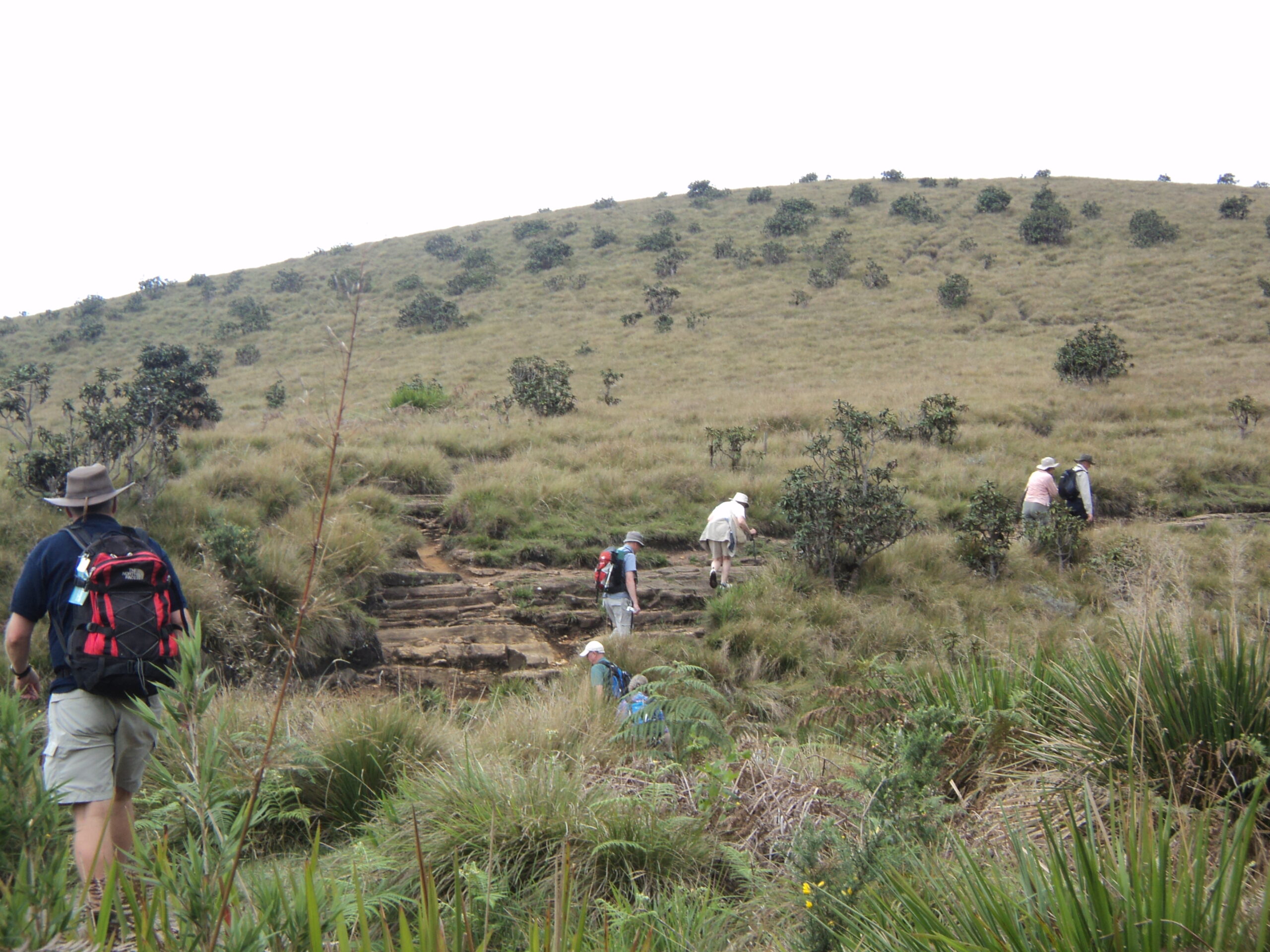 DAY 7, scenic region of Horton Plains,World’s End,Bakers Falls
DAY 7, scenic region of Horton Plains,World’s End,Bakers Falls
From Nuwaraeliya Hotel With a packed breakfast, leave for Horton Plains, Sri Lankas highest plateau very scenic region with an astounding variety of scenery from mountains to grasslands. Spectacular views from World’s End where the plateau plunges 700 meters in a sheer drop. Shrouded in cold mists on top of Sri Lanka’s mountains, at a height of more than 2,000m, lie the Horton Plains. A part of the Peak Wilderness Sanctuary and dramatically different from the coastal plains thousands of feet below, it is a plateau of 3,150 hectares in area. It is a wild and windswept plain of grasslands or patanas and patches of eerie forests. Residents include elk, monkeys, eagles, horned lizards and the occasional leopard. The Plains were uninhabited by the local population but were prized hunting and fishing grounds for the Europeans who “discovered” them in the early 19th century. Many landmarks are named after British governors, planters and hunters. Trout was introduced to the pristine rivers and lakes and still attract serious anglers, although a permit is now required. All other creatures on the plains are protected
After lunch, walk to the Bungalow in the tea plantation. Udavariya is a small tea village in the region of the Horton Plains.
Day 8, Trekking to Sri Lankas Highest waterfalls through Devil’s staircase and remote tea plantation
After Breakfast we start our trekking adventure, this is one of the most famous hikes in Sri Lanka, taking you to Bambarakanda Falls, the highest waterfall in Sri Lanka. You follow a path in the mountains with panoramic views.
Frist you visit the Bambarakanda waterfall and enjoy the waterfall and after you climb the pine forest and go to waterfall called “Lanka Falls” It is one of the most beautiful waterfalls, hidden in the forest Not many people visit this fall so most of the time the whole waterfall is just for you to enjoy. You can swim and have a cold bath in the natural pool at the base of the waterfall. You will have your picnic lunch,
After the cold swim and picnic, you will climb the forest to the tea plantation village and You pass through tea plantations and remote tea plantation villages. We will see village life and visit the little school in the village. The children will be very happy to ‘share’ sweets or pens if you happen to have any with you! Visitors are a welcome novelty! We shall see ladies ‘plucking’ the tea-taking ‘two leaves and a bud’ with their nimble fingers.
The trail will pass by abandoned estates, beautiful rolling hills covered with terraces of green tea and bubbling streams. You will also come across awe-inspiring views as you hike along the broken roads, and barely visible trails. You will then pass through an area called “Devil’s Staircase” a very narrow track with three hair pin bends and, at the end of this, more fascinating scenery in the tea estates. And for the evening tea you will reach the Lodge in the tea plantation for an overnight stay.
You enjoy every bit of the journey with though mind-blowingly beautiful scene Overnight in a hotel in Haputale
DAY 9 , Trekking through Sri Lankas Most beautiful Tea Plantations In the rolling misty green hills, The Ceylon Royal Tea Trails
After the breakfast in the guest house, we start our trekking in one of the most beautiful tea plantations in sri Lanka
Tea is the most popular beverage, next to water, in the World, the story of tea begins in China. According to legend, in 2737 BC, the Chinese emperor Shen Nung was sitting beneath a tree while his servant boiled drinking water, when some leaves from the tree blew into the water.
Whilst the custom of drinking tea dates back to the third millennium BC in China and was popularized in England during the 1660s by King Charles II and his wife the Portuguese Infanta Catherine de Braganza, it was not until the mid-19th century that the concept of ‘afternoon tea’ first appeared.
Tea production is one of the main sources of foreign exchange for Sri Lanka and accounts for Employments directly or indirectly, over 1 million people, and in 1995 directly employed 215,338 on tea plantations and estates. Sri Lanka is the world’s fourth-largest producer of Tea. In 1995, it was the world’s leading exporter of Tea The humidity, cool temperatures, and rainfall of the country’s central highlands provide a climate that favors the production of high-quality tea. The industry was introduced to the country in 1867 by James Taylor, a British planter who arrived in 1852. The major tea growing areas are Kandy and Nuwara Eliya in Central Province Badulla, Bandarawela and Haputale, Sri Lanka’s hill district is carpeted with beautiful terraced tea plantations. Perhaps the most famous is Lipton Tea original plantation near Haputale, which still grows and sells a variety of teas
Just drinking a few cups of tea and buying a couple of tea items on your visit to Sri Lanka, is really not the best way to get to know about this aspect of Ceylon. What you truly have to do to understand Sri Lankan Tea is to walk those estate paths and experience it for yourself.
Once you are familiar with the tea trees first hand, you can visit one of the tea Factory that provide tours about tea and how it’s processed from green leaves to a block cup of Tea
Sri Lanka is currently the fourth largest tea producer in the world. However, the history of tea in this country isn’t marked by how much is produced, but by the influence it has had on the nation and the tea culture as a whole. Each one of us, at some point in our lives, has heard of, seen, or drank Ceylon tea. Sri Lanka was known as Ceylon during the British colonial era, thus so was their tea.
A visit to sri lanka is not complete without visiting a tea plantation the tea trail is one of the best experience the clients can have about the tea plantation The tea trails is a walk about four to five hours it is walking in the most beautiful tea plantation with very nice landscape and panoramic view and a good experience for the High tea country and the panorama that Sri Lanka can offer also you will see the tea ladies plucking tea all day from 8 am to 4 pm rain or shine and also you will join the tea ladies to pluck some tea for an half an hour and you will visit one of the tea ladies house for a cup of Tea, and you will have a picnic in the tea plantation and you will meet only locals not a tourists once you finish the 6 Hours trekking we take a tuk tuk to the accommodation The Monisha Villa Home Stay where we will join the family to do the sri Lankan Food Cooking the You will do all the preparation and the cooking guide by Fathima who is famous for cooking class you can see in the trip adviser Sri Lanka Trekking Club once the cooking is finish you will enjoy a Dinner cooked by you
DAY 10 – beautiful train ride in Sri Lanka to Hatton from Bandarawela
By train, we cross the mountain passes for Hatton.The Bandarawela to Hatton train ride is the most beautiful train ride in Sri Lanka, if not in the world! Board the train and experience breathtaking views of lush green tea plantations, mountains, viaducts, valleys, and dense jungle. What’s more, it’s the perfect way to experience Sri Lankan life. Meet smiling locals on the train, wave to the running children along the tracks, and This is a must-do experience in sri lanka,and Hatton offers visitors a panoramic view of the surrounding mountains and waterfalls. Evening A short walk in the tea plantation. Dinner and overnight stay at a Dalhousie base of adamspeak
DAY 11 – The Sacred Mountain of Adam’s Peak
At midnight, climb Adam’s Peak, the cone shaped mountain that is probably the most venerated in the world. Walking through the night, we reach the peak at dawn in good time to witness the rising sun. As the sun climbs above the island, experience the magic of serendipity. The sunrise as seen from the summit of Adam’s Peak is considered to be one of the most spectacular phenomenon’s in the world. Have a late breakfast before leaving for Colombo. Overnight stay in Colombo or Negombo.
Enjoy the sand and the sea!
DAY 12, 13, Relax On The Beach
Relax two days on the beach.
DAY 14 – Transfer to the Airport
Transfer to the airport
- Day 10. You can make a change in the program and travel to the south coast of Sri Lanka, visiting the Yala or Udawalawa Natinal Park, Tangalle, Unawatuna, Galle and back to the airport.
- Tour Price Included
- Meet and assistance at the Colombo International Airport
- Daily Breakfast and dinners
- Guided sightseeing – Dambulla Rock Temple, Sigiriya, Polannaruwa
- Escorted by an English-German-French speaking national guide for big groups,
- Local professional trekking Guide
- Picnic lunch on the trekking
- Professional chauffeur guide English-German-French speaking
- transportation in private air-conditioned Car or Mini Van
- Accommodation in hotels, Guest Houses, Home stays, and lodges
- All Entrance fees and tickets as per the itinerary.
- Game drives in, Udawalawe and Yala National Parks
- Airport arrival and departure transfer
Tour Price Excludes
- Air ticket expenses from your country to Sri Lanka and return journey
- Extra items consumed / facilities utilized in hotels.
- Tips to service men and drivers.
- Expenses of personal nature such as liquor, cigarettes etc
- Camera Charges and video recording charges payable at the sites.
- Spa and Ayurweda treatments.
Tour No 4
THE SRI LANKA TREKKING HOLIDAY
13 NIGHTS / 14 DAYS
One Week of Unlimited Trekking Experience with Culture
Max 2 to 10 Persons
DAY 1, Colombo air port to Belihuloya village
Arrival in Colombo and transfer to Belihuloya, the drive to Belihuloya,from the airport about 5 hours via coconut, rubber, pineapples plantations with mountain views.
Belihuloya is a beautiful village located in the Ratnapura District of the Sabaragamuwa Province. and 616M above sea level. It consists of dry and wet zones as well as mountainous and lowland areas at an altitude of less than 1500 m. As a result, it consists of wet semi-evergreen forests, tropical forests, dry deciduous grasslands and mountainous tropical forests. we stay in Belihuloya, Rest House or Neyr by
DAY 2, Trekking Through Village,forest and paddy fielld & meet the locals
The trek starts from Belihuloya and we walk for about 6 hours in the village with rice fields and enter into a jungle with large trees. Birds and butterflies can be seen in the jungle. We walk in the village with rice fields and vegetables. We then go back into the jungle for an hour and climb to another village. We would walk through black pepper, cinnamon plantations and a few waterways.
DAY 3, Trekking to Sri Lankas Highest waterfalls through Devil’s staircase and remote tea plantation
After Breakfast we take a short transport, we start our trekking adventure This is one of the most famous hikes in Sri Lanka, taking you to Bambarakanda Falls, the highest waterfall in Sri Lanka. You follow a path in the mountains with panoramic views.
Frist you visit the Bambarakanda waterfall and enjoy the waterfall and after you climb the pine forest and go to waterfall called “Lanka Falls” It is one of the most beautiful waterfalls, hidden in the forest Not many people visit this fall so most of the time the whole waterfall is just for you to enjoy. You can swim and have a cold bath in the natural pool at the base of the waterfall. You will have your picnic lunch,
After the cold swim and picnic, you will climb the forest to the tea plantation village and You pass through tea plantations and remote tea plantation villages. We will see village life and visit the little school in the village. The children will be very happy to ‘share’ sweets or pens if you happen to have any with you! Visitors are a welcome novelty! We shall see ladies ‘plucking’ the tea-taking ‘two leaves and a bud’ with their nimble fingers.
The trail will pass by abandoned estates, beautiful rolling hills covered with terraces of green tea and bubbling streams. You will also come across awe-inspiring views as you hike along the broken roads, and barely visible trails. You will then pass through an area called “Devil’s Staircase” a very narrow track with three hair pin bends and, at the end of this, more fascinating scenery in the tea estates. And for the evening tea you will reach the Lodge in the tea plantation for an overnight stay.
You enjoy every bit of the journey with though mind-blowingly beautiful scene
DAY 4 – Trekking Through Thangamale Sanctuary, Tea Plantation and Natural & Man made Forest & Views to Haputale
After the Breakfast in the lodge, we start the forest walk Forests are known to have great therapeutic benefits for our body, mind and spirit. Scientific studies have shown that natural environments can have remarkable benefits for human health. Natural environments are more likely to promote positive emotions; walking in nature has been associated with heightened physical and mental energy.
Walking through various types of forests, not experienced by everyday tourists, we walk on a road for about a half hour and come to a panoramic view point in the tea plantation and walk about a 30 minute in the tea plantation and the Remote tea estate villages where the tea plantation workers live you will meet the family’s and the children’s, if you happen to have any sweets you can shire with them and they are happy to see a visitor pass by them because always they see the same Faces of the people who live there, and we see the lady’s picking tea in the plantation and we can also join them for 10 or 15 minutes to pick the tea and experience the tea picking that we drink tea all our life,
than go in to the forest and Pine Forest & Natural Forest also in the Eucalyptus Forest, Rain Forest, walk through the Tea Plantations of this Beautiful hill country and see Sri Lanka at its best. And one of the most beautiful Views of north and south can be seen in this walk. Also, we have the chance to walk in the railway line for an about half an hour also to go true a tunnel on the railway line, in this trekking we will have a picnic stop with a panoramic view and enjoy our picnic,
The forest walk is Considered one of the most beautiful treks in the country by the tourist who did the trek on the trek you will see some wildlife like toque macaques, purple faced langurs (Black Bear Monkey), wild boars, stripe necked mongooses, sri lankan spotted chevrotain, and grizzled giant squirrels. and birds like Yellow eared bulbul, crested serpent eagle, sri lanka junglefowl, Sri Lanka white-eye also you will see lizards like, Rhino hornlizard, Black-lipped Lizard
The 5-to 6-hours trek you will enjoy every foot of it once we finish the trekking in our Guest house in Haputale we stay overnight in Guest House and we will have our Dinner in the guest house
DAY 5 – Trekking through Sri Lankas Most beautiful Tea Plantations In the rolling misty green hills, The Ceylon Royal Tea Trails
After the breakfast in the guest house, we start our trekking in one of the most beautiful tea plantations in sri Lanka
Tea is the most popular beverage, next to water, in the World, the story of tea begins in China. According to legend, in 2737 BC, the Chinese emperor Shen Nung was sitting beneath a tree while his servant boiled drinking water, when some leaves from the tree blew into the water.
Whilst the custom of drinking tea dates back to the third millennium BC in China and was popularized in England during the 1660s by King Charles II and his wife the Portuguese Infanta Catherine de Braganza, it was not until the mid-19th century that the concept of ‘afternoon tea’ first appeared.
Tea production is one of the main sources of foreign exchange for Sri Lanka and accounts for Employments directly or indirectly, over 1 million people, and in 1995 directly employed 215,338 on tea plantations and estates. Sri Lanka is the world’s fourth-largest producer of Tea. In 1995, it was the world’s leading exporter of Tea The humidity, cool temperatures, and rainfall of the country’s central highlands provide a climate that favors the production of high-quality tea. The industry was introduced to the country in 1867 by James Taylor, a British planter who arrived in 1852. The major tea growing areas are Kandy and Nuwara Eliya in Central Province Badulla, Bandarawela and Haputale, Sri Lanka’s hill district is carpeted with beautiful terraced tea plantations. Perhaps the most famous is Lipton Tea original plantation near Haputale, which still grows and sells a variety of teas
Just drinking a few cups of tea and buying a couple of tea items on your visit to Sri Lanka, is really not the best way to get to know about this aspect of Ceylon. What you truly have to do to understand Sri Lankan Tea is to walk those estate paths and experience it for yourself.
Once you are familiar with the tea trees first hand, you can visit one of the tea Factory that provide tours about tea and how it’s processed from green leaves to a block cup of Tea
Sri Lanka is currently the fourth largest tea producer in the world. However, the history of tea in this country isn’t marked by how much is produced, but by the influence it has had on the nation and the tea culture as a whole. Each one of us, at some point in our lives, has heard of, seen, or drank Ceylon tea. Sri Lanka was known as Ceylon during the British colonial era, thus so was their tea.
A visit to sri lanka is not complete without visiting a tea plantation the tea trail is one of the best experience the clients can have about the tea plantation The tea trails is a walk about four to five hours it is walking in the most beautiful tea plantation with very nice landscape and panoramic view and a good experience for the High tea country and the panorama that Sri Lanka can offer also you will see the tea ladies plucking tea all day from 8 am to 4 pm rain or shine and also you will join the tea ladies to pluck some tea for an half an hour and you will visit one of the tea ladies house for a cup of Tea, and you will have a picnic in the tea plantation and you will meet only locals not a tourists once you finish the 6 Hours trekking we take a tuk tuk to the accommodation The Monisha Villa Home Stay where we will join the family to do the sri Lankan Food Cooking the You will do all the preparation and the cooking guide by Fathima who is famous for cooking class you can see in the trip adviser Sri Lanka Trekking Club once the cooking is finish you will enjoy a Dinner cooked by you
DAY 6, Trekking to Ella Attraction’s scenic Ella rock, amazing views of small Adams peak & famous Nine arches Bridge
Ella is a beautiful small town in the south of Sri Lanka in the Hill country. It is a great base for tourists who want to explore the surrounding hills and enjoy the breathtaking views of Badulla’s green valleys. The weather is usually quite humid, with moderate air temperature, sunny mornings, and often rain showers in the afternoon.
Visiting Ella is not complete without climbing the Most Famous Ella Rock The most rewarding, and most taxing, hike around Ella is the ascent of the majestic Ella Rock,
Ella Rock is a famous cliff, located high above Ella’s village, roughly a two hours strenuous trek from the center of town. The rock offers stunning views across the hill country, and the plains below. The trek to Ella Rock is about 8 km long Trekking to Ella Rock and back is around 4 hours from start to finish
The total climb up Ella Rock is one thousand meters, or 3300ft, giving the summit a total height of 2000 meters. It can be quite a tricky walk-in part, particularly approaching the top which has some steep stretches
All the tourist visits Ella going up the Ella rock and back in the same way but we take you a round tour to the Ella rock via forest, village and vegetable grow so while you climb the Ella rock you are making a good trekking and we will organize a picnic lunch for you to enjoy on the ella rock Your lunch will consist of Sandwiches of two kinds pancake with coconut sugar, along with some seasonal fruits for dessert. After the picnic and a good rest, after picnic we hike to the pickup point by tuk tuk to go to mini-Adam speak
If you know Sri Lanka, you’ll know all about Adam’s Peak but you may, not have heard of Little Adam’s Peak (Mini Adam’s Peak or Small Adam’s Peak)
Little Adam’s Peak is just one of it. The eye catching, jaw dropping and conspicuous peak is the one not to miss, situated in Ella, Sri Lanka, it has been attracting tourists for a long time now. The reason for its popularity is the amazing view that never fails to attract and impress the visitors.
This mountain has an elevation of 1141 m above sea level, and gains its name from its similarity of style to the famous Adam’s Peak, the fifth tallest mountain in Sri Lanka. The summit of the mountain has great panoramic views, especially in the morning When You will be hiking. After spending sometime at the top, you will be returning to the base. The entire climb up and down will take two hours
After you will hike cross country for 40 minutes through some woods to reach the Nine Arches Bridge. This incredible historical viaduct built Entirely from stone, bricks and cement (with no steel) was created in the British era of Sri Lanka. It spans a space of over 300 feet and has a height of approximately 100 feet. You will be able walk along the railroad passing over the bridge, You Can Also get some excellent photographs and create some memories. Overnight in a guest House in Ella
DAY 7, – Cultural and nature Walk in Sacred City of Kandy, to see three temples
After an early breakfast, leave for Kandy, on route visiting tea plantations and a tea factory to watch the process of turning the raw green leaf into the familiar dark product. And From Peradeniya, we walk to see the temples Hambacka, Gadaladaniya. and Lankathilaka in Kandy, and overnight in kandy
Lankatilaka Temple
Lankatilake temple is a magnificent building built on rock at a scenic location which also has fine paintings.
Gadaladeniya Temple
This 14-century temple is situated about 15Km from the town. The structure of the temple is influenced by the South Indian architecture and built on a rock. The stupa is on a high stone platform.
Embekke Temples
The main attraction is the intricate wooden carvings of this 14th century shrine dedicated to God Kataragama. There is also a Buddhist temple on location. Almost the entire structures of some wooden buildings are decorated with dancers, musicians, wrestlers, legendary beasts and birds. Nearby are the ruins of an ancient rest house with similar pillars carved in stone.

DAY 8 – Sacred City of Kandy, Royal Botanic Gardens, tooth temple and candy city tour
Kandy, the last royal capital of Sri Lanka is a major tourist destination. ( 115kM from Colombo at 465 meters above sea level). Famous for the Temple of the Tooth and many other temples the city could be called the cultural capital of the island.
Kandy Perahera, the pageant of the temple of tooth where Buddha’s tooth is kept is held either in July or August each year to parade the golden caskets is a must see itenary if one is visiting Sri Lanka during these months. The final night procession is the most spectacular event of the country. More than 50 elephants parade the city accompanied by the drummers, dancers and chieftains.
he city established in the 15th century was the last royal capital where 2500 years of royal rule ended. This bustling market town is rich in cultural diversity has plenty of iteneries to offer to the tourists from songs dances and handy crafts to ancient temples and adventure activities. Kandy is a good transit point to the cultural triangle to the north or hill country to the south. The city is also a good source of souvenirs or to experience many cultural performances at it’s various hotels in the city.
city tour, upper lake drive, Udawaththa Kelle nature reserve, sacred Temple of the Tooth relic, Royal Botanical Gardens, arts and crafts workshop, market and bazaar. Dinner and overnight stay in Kandy.
Royal Botanic Gardens, Peradeniya are about 5.5 km to the west of the city of Kandy in the Central Province of Sri Lanka. It attracts 2 million visitors annually. It is near the Mahaweli River (the longest in Sri Lanka). It is renowned for its collection of orchids. The garden includes more than 4000 species of plants, including orchids, spices, medicinal plants and palm trees Attached to it is the National Herbarium of Sri Lanka. The total area of the botanical garden is 147 acres (0.59 km2), at 460 meters above sea level, and with a 200-day annual rainfall. It is managed by the Division of National Botanic Gardens of the Department of Agriculture.
The origins of the Botanic Gardens date as far back as 1371 when King Wickramabahu III ascended the throne and kept court at Peradeniya near the Mahaweli river. This was followed by King Kirti Sri and King Rajadhi Rajasinghe. A temple was built on this location by King Wimala Dharma, but it was destroyed by the British when they were given control over the Kingdom of Kandy
Thereafter, the groundwork for a botanical garden was formed by Alexandar Moon in 1821. He used the garden for coffee and cinnamon plants. The Botanical Garden at Peradeniya was formally established in 1843 with plants brought from Kew Garden, Slave Island, Colombo, and the Kalutara Garden in Kalutara. The Royal Botanic Garden, Peradeniya was made more independent and expanded under George Gardner as superintendent in 1844. On Gardner’s death in 1849 George Henry Kendrick Thwaites became superintendent. He served until he resigned in 1879, when he was succeeded by Henry Trimen, who served until 1895.
The garden came under the administration of the Department of Agriculture when it was established in 1912.
There are avenues in the River Drive such as Cook’s Pine Avenue, Palmyra Palm Avenue, Double Coconut Avenue, Cabbage Avenue, and Royal Palm Avenue. The classical Avenue of Palms is in this Garden. One item with a significant history is the Cannonball Tree planted by King George V of the United Kingdom and Queen Mary in 1901. It is often laden with fruit, which are thought to resemble cannonballs.
During World War II, the Botanic Garden was used by Lord Louis Mountbatten, the supreme commander of the allied forces in the South Asia, as the headquarters of the South East Asia Command. Over Night in kandy


DAY ,9, Knuckles Mountain Range Trekking
Morning from the hotel we drive to The Knuckles Mountain Range lies in the north-east of the Kandy city. The range is characterized by its well-known landscapes frequently covered by clouds. In addition to its aesthetic value, the range has a great tropical biodiversity and subject to the interest of scientists.
Afternoon well do some trekking in the aria see some paddy field, village and see the nature and over night stay in a simple accommodation with dinner

DAY 10 – Knuckles Mountain Range Manigala Trekking
Morning after early brackfast we start the adventure of the day Manigala Climb in the Knuckles Conservation Center to Illukkumbura through mountains, plains and parks.
We start the trekking journey from the beautiful Rathinda village and going through the village to the starting point will be priceless. Adjacent to Rathinda’s real rural life, you can see paddy fields, plantations and all the rural beauty.
The height of the top of Manigala hill is 1104 meters. To cross it you have to walk along a difficult road about 3 km from the village of Atenwala. It usually takes two to three hours to reach the top of the mountain. It is considered to be one of the most beautiful landmarks in the world as it is surrounded by foggy mountains.
enjoy This majestic Manigala mountain range and its surroundings is an ecosystem and the natural beauty. Overnight stay in a simple accommodation with Dinner

DAY 11 – Sri Lankas cultural Triangle Polonnaruwa and Sigiriya
Early morning, we drive to Sigiriya and afternoon Visit to 5th century rock fortress A World Heritage Sigiriya is one of the most valuable historical monuments of Sri Lanka. Referred by locals as the Eighth Wonder of the World this ancient palace and fortress complex has significant archaeological importance and attracts thousands of tourists every year. It is probably the most visited tourist destination of Sri Lanka.
Sigiriya rock plateau, formed from magma of an extinct volcano, is 200 meters higher than the surrounding jungles. Its view astonishes the visitors with the unique harmony between the nature and human imagination.
The fortress complex includes remnants of a ruined palace, surrounded by an extensive network of fortifications, vast gardens, ponds, canals, alleys and fountains.
The surrounding territories of Sigiriya were inhibited for several thousand years. Since 3th century BC the rocky plateau of Sigiriya served as a monastery. In the second half of the 5th century king Kasyapa decided to construct a royal residence here.
After his death Sigiriya again became a Buddhist monastery until the 14th century, when it was abandoned.
The main entrance is located in the northern side of the rock. It was designed in the form of a huge stone lion, whose feet have survived up to today but the upper parts of the body were destroyed.
Thanks to this lion the palace was named Sigiriya. The term Sigiriya originates from the word Sihagri, i.e. Lion Rock.
The western wall of Sigiriya was almost entirely covered by frescoes, created during the reign of Kasyapa. Eighteen frescoes have survived to this day.
The frescoes are depicting nude females and are considered to be either the portraits of Kasyapa’s wives and concubines or priestess performing religious rituals. Despite the unknown identity of the females depicted in the frescoes, these unique ancient paintings are celebrating female beauty and have incredible historical significance.
One of the most striking features of Sigiriya is its Mirror wall. In the old days it was polished so thoroughly that the king could see his reflection in it. The Mirror wall is painted with inscriptions and poems written by the visitors of Sigiriya.
The most ancient inscriptions are dated from the 8th century. These inscriptions are proving that Sigiriya was a tourist destination more than a thousand years ago. Today, in Hotel in Sigiriya.
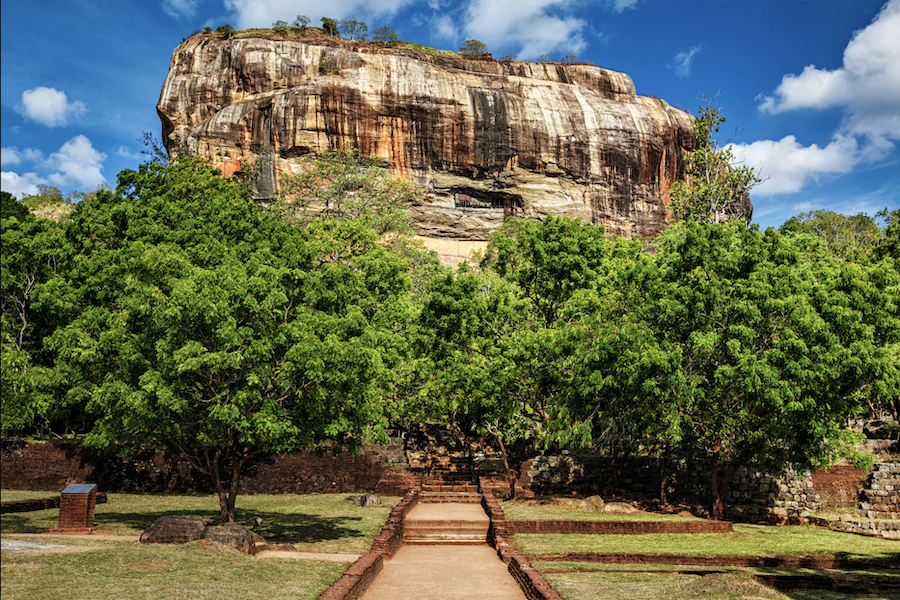
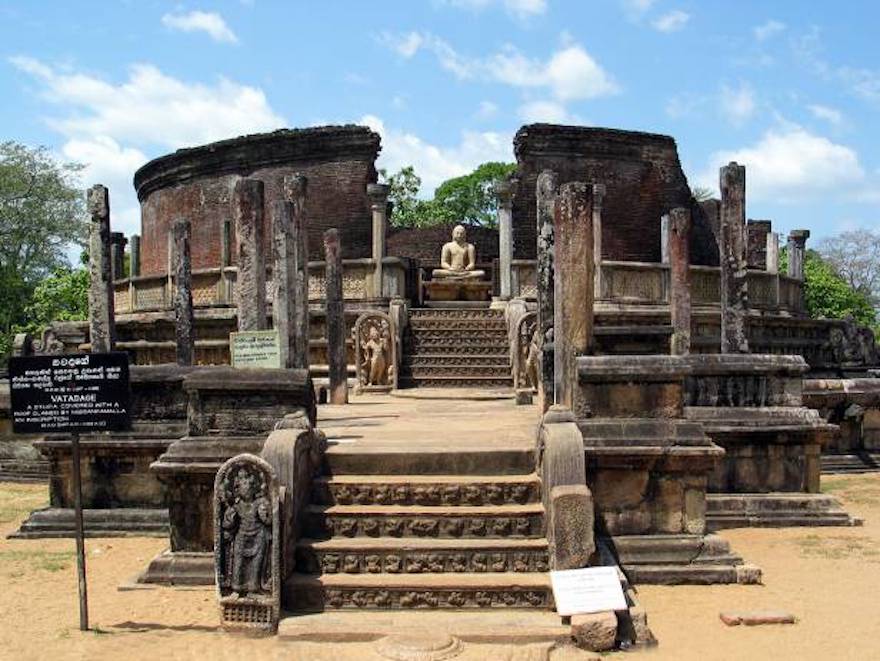
DAY 12 – Sri Lankas cultural Triangle Polonnaruwa and Sigiriya
After breakfast at the hotel, we will do some sightseeing in Polonnaruwa by bicycles, which was the 2nd capital city of Sri Lanka, built in the 11th and 12th centuries AD and which is a World Heritage Site. You can see the ruins of the Royal Palace, the Gal Viharaya – where 4 splendid statues of the Buddha in “Upright”, “Sedentary” and “Recumbent” postures carved out of rock. We would also see the Audience Hall, the Lotus Bath, king Parakramabahu’s statue and the Parakrama Samudraya Lake built by King Parakramabahu the great. There are monuments of famous places of worship such as the the Watadage, the Galpotha, the Kiri Vehera and the remains of a former Tooth Relic. Accommodation in Hotel in Sigiriya.
DAY 13, cultural Triangle to Negombo via Elephant Orphanage
Morning from sigiriya we drive to Negombo on the way we Visit Elephant Orphanage Pinnawala is the only Elephant orphanage in Sri Lanka which was established in 1975 started with 5 orphaned elephants and the current population is 93 of both sexes / all age groups. Prime purpose of the Pinnawala Elephant orphanage is to provide refuge for the elephants which are injured / orphaned & abandoned in the wild. This orphanage is operating as a breeding ground too since 1980. Most of the new arrivals are babies and after a few days of quarantine, they are released into the herd who welcome them happily. Orphanage covers an area of 23-acre land in the middle of the county & managed by the Department of National Zoological Gardens. This is the largest captive herd of elephants in the world belonging to the Elephas maximus maximus.
After we drive to Negombo and you can Enjoy the Beach in Negombo.
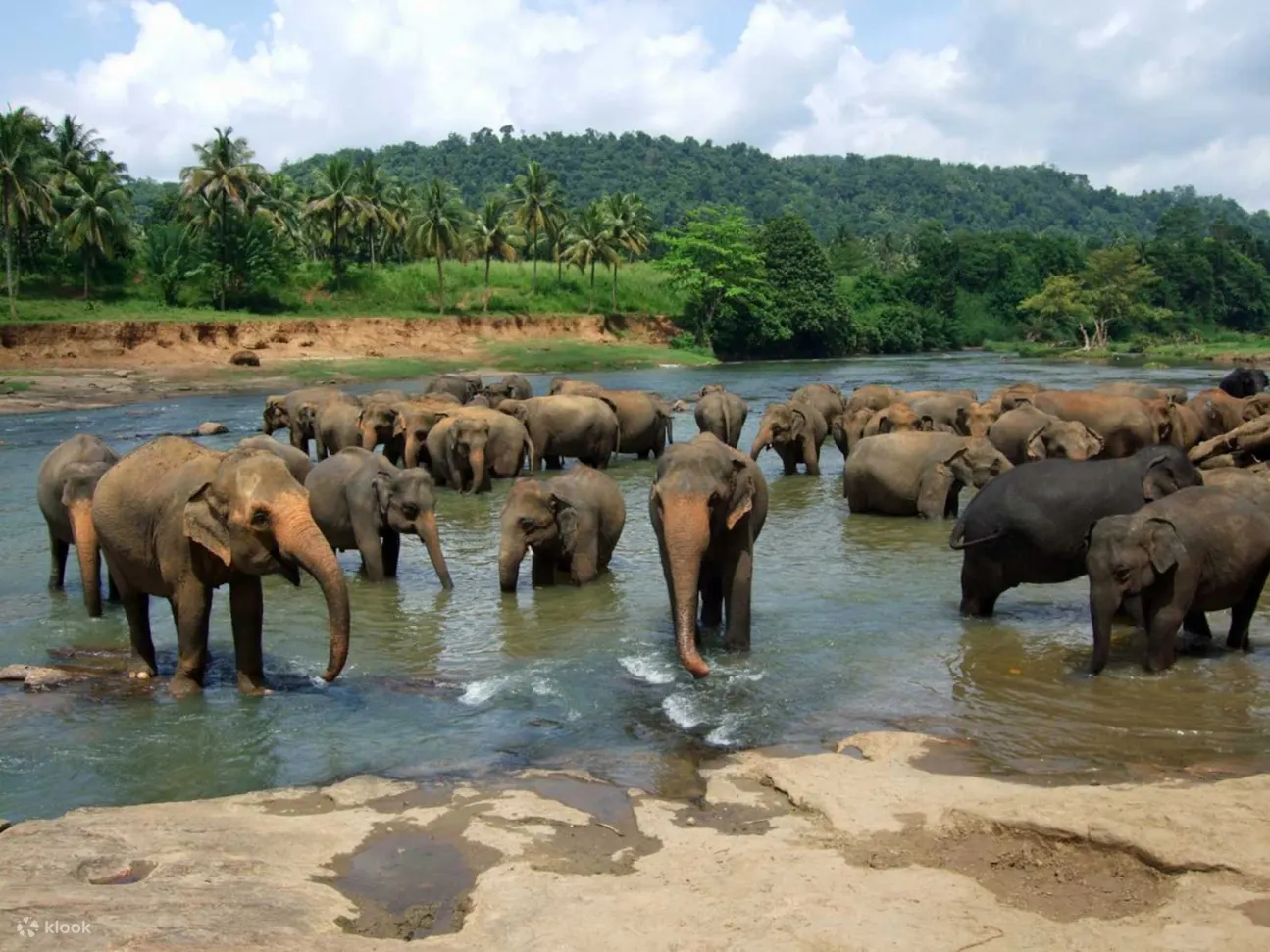
DAY 14
end of the holidays andTransfer to the airport
Tour Price Included
- Meet and assistance at the Colombo International Airport
- Daily Breakfast and dinners
- Guided sightseeing – Dambulla Rock Temple, Sigiriya, Polannaruwa
- Escorted by an English-German-French speaking national guide for big groups,
- Local professional trekking Guide
- Picnic lunch on the trekking
- Professional chauffeur guide English-German-French speaking
- transportation in private air-conditioned Car or Mini Van
- Accommodation in hotels, Guest Houses, Home stays, and lodges
- All Entrance fees and tickets as per the itinerary.
- Game drives in, Udawalawe and Yala National Parks
- Airport arrival and departure transfer
Tour Price Excludes
- Air ticket expenses from your country to Sri Lanka and return journey
- Extra items consumed / facilities utilized in hotels.
- Tips to service men and drivers.
- Expenses of personal nature such as liquor, cigarettes etc
- Camera Charges and video recording charges payable at the sites.
- Spa and Ayurweda treatments.
Tour No 5
RAIN FOREST, TREKKING, CULTURE & BEACH HOLIDAY
13 NIGHTS / 14 DAYS
Max 2 to 10 Persons
DAY 1 – Colombo air port to Negombo
Arrival at the Colombo Airport. Meet and transfer to Negombo. Rest of the evening at leisure. Dinner and overnight at hotel.

DAY 2 – Sri Lankas cultural Triangle Polonnaruwa and Sigiriya via Elephant Orphanage
Early breakfast we start our tour for Polannaruwa. On route, we visit the elephant orphanage at Pinnawela
Pinnawala Elephant Orphanage is an Orphanage, Nursery and Captive breeding ground for wild Asian Elephants located at Pinnawela village, Pinnawala has the largest herd of captive elephants in the world. In 2011, there were 88 elephants, including 39 males and 49 females from 3 generations, living in Pinnawala
The orphanage was founded to care and protect the many orphaned unwanted wild elephants found wandering in and near the forests of Sri Lanka. It was established in 1975 by the Sri Lanka Department of wildlife Conserve
Tourists can observe the bathing elephants from the broad river bank as the herd interacts socially, bathing and playing. The orphanage is open to the public daily, and all admission fees are used to look after the elephants Visitors to the park can view the care and daily routine of the elephants, such as bottle feeding of elephant calves, feeding of all other elephants, and bathing in the Ma Oya (River).
The orphanage was established to feed, nurse and house young elephants found abandoned by their mothers. Young elephants sometimes fall into pits and ravines in their quest for water during drought period. Other orphans have been displaced from their wild habitat by development projects or have been found abandoned before weaning, diseased or wounded.
There are 48 Mahouts (handlers) who take care of the elephants. The female and young elephants in Pinnawala range freely as a herd during the day in an area of a few acres. They are herded about .5 km (0.31 mi) twice a day to drink and be bathed in the river. At night, the females are individually chained in stalls. Adult males do some light work such as transporting feed. They are chained and managed individually. Calves born in Pinnawala are not bottle fed, but a few from ETH are kept at Pinnawala and bottle fed as a tourist attraction.
The elephants are fed in their stalls. There is very little food they can gather from the premises of the orphanage except some grass. Large quantities of Jackfruit,Coconut, Kitul (sugar palm),tamarind and grass, brought in daily, form the bulk of the elephants food. Each adult animal is given around 250 kilograms (550 lb) of this green matter per day and around 2 kg (4.4 lb) from a food bag containing rice bran

DAY 3 – Sri Lankas cultural Triangle Polonnaruwa and Sigiriya
Polonnarwa After breakfast at the hotel, we will do some sightseeing by bicycles in Polonnaruwa, which was the second capital city of Sri Lanka. This ancient city was built in the 11th and 12th centuries AD and is presently a World Heritage Site. You can see the ruins of the Royal Palace, the Gal Viharaya – where 4 splendid statues of the Buddha in “upright”, “sedentary” and “recumbent” postures carved out of rock. Visit the Audience Hall, the Lotus Bath, king Parakramabahu’s statue, and the Parakrama Samudraya Lake built by King Parakramabahu the great. There are also monuments of famous places of worship such as the Shiva Temple, the Watadage, the Galpotha, the Kiri Vehera and the remains of a former Temple of the Tooth Relic.
After lunch, visit the 5th century rock fortress of Sigiriya. A World Heritage Site, it is now one of Sri Lanka’s major attractions rising two hundred meters from the jungle floor. At the rocks base are extensive gardens, ramparts and a moat. During our visit to this unique complex, we will see water gardens, ancient frescoes, the stone mirror wall and the lion platform. For the fittest, a climb up to the summit would be an achievement!

DAY 4, Sacred City of Kandy Dambulla cave temple
After breakfast at the hotel, we will drive to Kandy visiting Dambulla, Kandy is the last Royal Kingdom of Sri Lanka with picturesque landscape surrounded by beautiful mountains located in the central part of the island positioned 1,600 feet above the MSL- Mean Sea Level. Kandy Sri Lanka is well known with the Sacred Tooth relic Temple which is most venerated Buddhist Temple and The Royal Botanic Gardens with more that 4,000 labeled species of flora and also Kandy is a “Planned City” during British colonial period of Ceylon. Considering these facts UNESCO declared Kandy as a UNESCO World Heritage. Today Kandy is the second most famous city of Sri Lanka with a total area of 1,940 SQ KM and major tourist attraction. Culturally, Kandy plays a vital role with the mix cultures of Sinhala & Tamil communities. Sri Dalada Maligawa or the Temple of the Sacred Tooth Relic was built within the royal palace complex which houses the only surviving relic of Buddha.
During the month of August Kandy becomes highly crowded due to the Kandy Esala Perehera which is hosted as an annual tradition of the Temple of the Sacred Tooth. It usually attracts a large number of local and foreign tourists who value tradition, customs and Buddhist heritage. This egregious night parade stalks more than 50 elephants along with colorful kandyan dancers and drummers.
Your trip to Kandy will not be completed without a tour around the charming lake of Kandy. It is another fascinating attraction in this city which was built by the King Sri Wikrama Rajasinghe in 1806. By considering all of these reasons UNESCO declared this city as a world heritage under the name of Sacred City of Kandy.
.Dambulla is a part of the Cultural Triangle declared by UNESCO and is on the main road from Sigiriya to Kandy about 19km from Sigiriya. There are over 80 caves in the surrounding area and some of them have been used by the monks as meditation locations. Major attractions are spread over 5 caves which contain the statues and the paintings. Since its founding in the first century BC by King Valagamba, many improvements and additions have been carried out to the sculptures and paintings over the years. Hindu statues are believed to be of the 12th century AD and the latest paintings are of the late 18th century. The temple is a perfect location to view evolution of the ancient Sri Lankan arts. Dambulla is a unique and important historical site because of the amalgamation of the material from many eras.
After lunch in Kandy, visit the sacred Temple of the Tooth Relic and followed by a Kandyan dance program. Over night in kandy
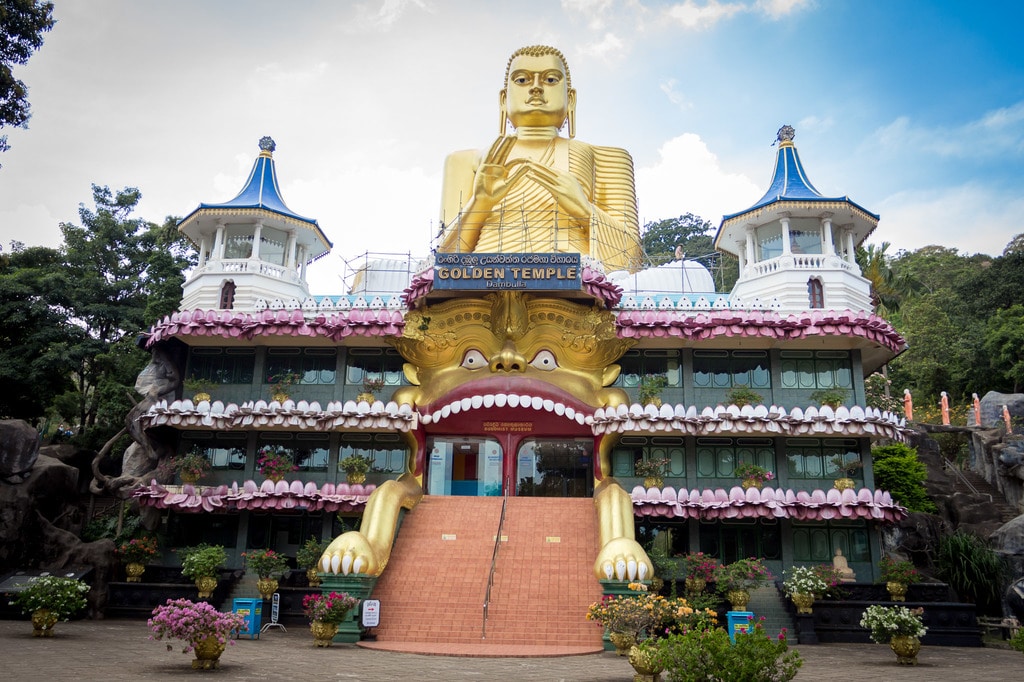
DAY 5 – Sacred City of Kandy, Royal Botanical Gardens
Today you will explore the Kandy city and surroundings, Morning after early breakfast in the hotel you will visit Royal the Botanical Gardens in Peradeniya In ancient times the garden has been frequented by royalty as King Keerthi Sri Rajasingha has used it as his courts. With the colonial rule in Sri Lanka the garden received its official botanical garden state when Edward Barnes was the governor. It is said that the plants were even brought from the Kew Gardens to the Peradeniya gardens when the British were giving a new look to the Royal Botanical Gardens. The first tea seedling that was planted in Ceylon was at this Botanical Garden during Edwards Barnes’s time. During the Second World War it has been used as the headquarters of the South East Asia Command by Lord Mountbatten. Today it bears some of the exquisite orchids, indigenous plants and herbs and memorable plants like the Cannonball tree that was planted in 1901 by King George V and Queen Mary of the United Kingdom. This is the most extensive and the largest Botanical Garden in Sri Lanka that covers about 146 acres in ground. The most famous and classical Avenue of Palms gives a stately look to the Botanical gardens and the most popular feature is the orchid house that has a magnificent collection of orchids and it is especially renowned for the diverse range of orchids grown in the greenhouse. The garden features about 400 species of the plants and the sheer beauty and the exquisiteness of the plants and flowers attract about 2 million visitors per year. And make sure you see the dome-like mammoth Javan fig tree that covers about 2500 square meters. You would be dwarfed at the mere sight of this tree that is located in the great lawn.
Morning visit the Royal Botanical Gardens, you can walk in upper lake drive, and a hike in the Udawaththa Kale nature reserve, visit arts and crafts workshop, and walk to market and bazaar. Overnight in kandy
DAY 6 – Haputale via Nuwaraeliya Through tea plantation, factory & panoromic views
Drive to the mountains En route visit the tea factory where you will learn how the green tea leaves are treated to become high quality “Ceylon Tea” and visit the Nuwaraeliya , Nuwara Eliya city in the Central Mountain Range of Sri Lanka. Blessed a with salubrious climate, breathtaking views of valleys, meadows, mountains and greenery it’s hard to imagine that Nuwara Eliya is only 180 Km from the colombo
Nuwara Eliya, also known as ‘Little’ England’, was the favorite hill station of the British who tried to create the resort into a typical English Village. The old brick Post office, country house like hill club, with its hunting pictures, mounted hunting trophies and fish, and its strict formal dinner attire; the 18-hole golf course, race course etc enjoy the site seen of the nuwaraeliya and drive to Haputale and the overnight stay in a guest house in Haputale.
DAY 7, Horton Plains, World’s End Nature tour day
With a packed breakfast we Drive to Horton Plains, the drive is about 1 hour and from the entrance to the park and from the entrance well hike about 3 hours in the park of Horton’s plane
Sri Lankas highest plateau very scenic region with an astounding variety of scenery from mountains to grasslands. Spectacular views from World’s End where the plateau plunges 700 meters in a sheer drop. Shrouded in cold mists on top of Sri Lanka’s mountains, at a height of more than 2,000m, lie the Horton Plains. A part of the Peak Wilderness Sanctuary and dramatically different from the coastal plains thousands of feet below, it is a plateau of 3,150 hectares in area. It is a wild and windswept plain of grasslands or patanas and patches of eerie forests. Residents include elk, monkeys, eagles, horned lizards and the occasional leopard. The Plains were uninhabited by the local population but were prized hunting and fishing grounds for the Europeans who “discovered” them in the early 19th century. Many landmarks are named after British governors, planters and hunters. Trout was introduced to the pristine rivers and lakes and still attract serious anglers, although a permit is now required. All other creatures on the plains are protected
After lunch, walk to the Bungalow in the tea plantation. Udavariya is a small tea village in the region of the Horton Plains.
DAY 8, Trekking Through Thangamale Sanctuary, Tea Plantation and Natural & Man made Forest & Views to Haputale
After the Breakfast in the lodge, we start the forest walk Forests are known to have great therapeutic benefits for our body, mind and spirit. Scientific studies have shown that natural environments can have remarkable benefits for human health. Natural environments are more likely to promote positive emotions; walking in nature has been associated with heightened physical and mental energy.
Walking through various types of forests, not experienced by everyday tourists, we walk on a road for about a half hour and come to a panoramic view point in the tea plantation and walk about a 30 minute in the tea plantation and the Remote tea estate villages where the tea plantation workers live you will meet the family’s and the children’s, if you happen to have any sweets you can shire with them and they are happy to see a visitor pass by them because always they see the same Faces of the people who live there, and we see the lady’s picking tea in the plantation and we can also join them for 10 or 15 minutes to pick the tea and experience the tea picking that we drink tea all our life,
than go in to the forest and Pine Forest & Natural Forest also in the Eucalyptus Forest, Rain Forest, walk through the Tea Plantations of this Beautiful hill country and see Sri Lanka at its best. And one of the most beautiful Views of north and south can be seen in this walk. Also, we have the chance to walk in the railway line for an about half an hour also to go true a tunnel on the railway line, in this trekking we will have a picnic stop with a panoramic view and enjoy our picnic,
The forest walk is Considered one of the most beautiful treks in the country by the tourist who did the trek on the trek you will see some wildlife like toque macaques, purple faced langurs (Black Bear Monkey), wild boars, stripe necked mongooses, sri lankan spotted chevrotain, and grizzled giant squirrels. and birds like Yellow eared bulbul, crested serpent eagle, sri lanka junglefowl, Sri Lanka white-eye also you will see lizards like, Rhino hornlizard, Black-lipped Lizard
The 5-to 6-hours trek you will enjoy every foot of it once we finish the trekking in our Guest house in Haputale we stay overnight in Guest House and we will have our Dinner in the guest house
DAY 9 – Bandarawela to Hatton beautiful train ride in Sri Lanka & Adam’s Peak
By train, we cross the mountain passes for Hatton.The Bandarawela to Hatton train ride is the most beautiful train ride in Sri Lanka , if not in the world! Board the train and experience breathtaking views of lush green tea plantations, mountains, viaducts, valleys, and dense jungle. What’s more, it’s the perfect way to experience Sri Lankan life. Meet smiling locals on the train, wave to the running children along the tracks, and This is a must-do experience in sri lanka,and Hatton offers visitors a panoramic view of the surrounding mountains and waterfalls. Evening A short walk in the tea plantation. Dinner and overnight stay at a Dalhousie base of adamspeak
Sri Pada or Adam’s Peak is an ancient pilgrimage site, which has long attracted thousands of pilgrims from all faiths. This conical mountain is 7,360 feet (2,250 meters) high, soaring clear above the surrounding mountain ranges. The mountain is located in the southern reaches of the Central Highlands in the Ratnapura District The surrounding region is largely forested hills, with no mountain of comparable size nearby.
The region along the mountain is a wildlife reserve, housing many species varying from elephants to leopards, and including many endemic species. The region of Peak Wilderness Sanctuary that encompass the Sri Pada
Sri Pada is derived from Sanskrit, used by the Sinhalese people in a religious context; roughly translated as “the sacred foot”, It refers to the footprint-shaped mark at the summit, which is believed by Buddhists to be that of the Buddha. Christian and Islamic traditions assert that it is the footprint of Adam,
left when first setting foot on Earth after having been cast out of paradise, giving it the name “Adam’s Peak”. The legends of Adam are connected to the idea that Sri Lanka was the original Eden, and in the Muslim tradition that Adam was 30 ft tall. Hindu tradition refers to the footprint as that of the Hindu deity Shiva, and thus names the mountain Shiva padam (Shiva’s foot) in Tamil.
After coming down you can have a shaver and Late breakfast at the hotel before leaving for Sinharaja rainforest and you can have a short sleep on the drive Overnight in hotel around sinharaja Or Udawalawa
DAY 10 – Sinharaja rainforest Or Udawalawa National Park.
An early morning start as we visit the Sinharaja rainforest or Udawalawa National Park.
Sinharaja Rainforest the Sinharaja forest reserve is one of the least disturbed and biologically unique lowland rainforests in Sri lanka. This forest covers an extent of about 11187 hectares from east to west. The length of the forest is about 21km and the width from North to South is about 3.7km. It was declared a Man and Biosphere Reserve (MAB) in 1978, as representative of tropical humid evergreen forest eco system in Sri Lanka and has been recognized by UNESCO as part of its International Network of Biosphere reserves. It was declared a National Wilderness Area in 1988 and lately a World Heritage Site since 1989. Sinharaja is situated in the southwest lowland wet zone of Sri Lanka.
Or You Can Visit
Udawalawe National Park
The park is situated just south of the Central Highlands, of which escarpment brings about an enrapturing backdrop. At the center of the park lies the Udawalawe Reservoir. Keeping company to the herds of elephants, the main attraction of the park are the Water Buffalo, Wild boar, Spotted Deer, Sambar deer, Jackal, Black-napped hare, mongooses, bandicoots, foxes, s the endemic Toque Macaque and Gray Langer’s. Sighting a Leopard and other smaller cats like Fishing cat & Jungle cat would be a bonus. Udawalawe is undoubtedly the best place in Sri Lanka to see wild Asian Elephants throughout the year: there are about 500 elephants in the park and they often roam in herds of up to 100. Udawalawe National Park is unique in terms of consistency in numbers of elephants roaming the park: it has no a seasonal variation in herds of elephants. Birdlife at Udawalawe National Park is one of the best places to see Raptors in Sri Lanka and afford excellent opportunities for photography. Endemic birds include the Sri Lankan junglefowl, Sri Lanka spurfowl, Sri Lanka green pigeon, Sri Lanka grey hornbill, Sri Lanka wood shrike and Sri Lanka swallow. Among the other bird species seen are Spot-billed pelican, little cormorant, grey heron, Indian pond heron, Cattle egret, Great egret, little egret, Intermediate egret, Painted stork, Woolly-necked stork, Yellow-wattled lapwing, Green bee-eater, Crested treeswift. are found. and
Butterflies like Satin trees in the park attract butterflies: beautiful Papilio crino, Delias eucharis, Euploea core and many species of ‘Yellows and Whites’ Papilio polytes. In the riverine forest areas Graphium sarpedon are seen. Reptiles While the crocodiles doze off on the banks of the reservoir, the water monitor lizards are abound in the park.
Elephant Transit Home (ETH) at Udawalawe National Park
The Udawalawe Elephant Transfer Home is an Elephant orphanage located within the Udawalawe National Park. Established in 1995 by the Department of wildlife Conservation, it is home to over 40 orphaned elephants. The orphaned calves and juveniles of the park are brought into the orphanage and raised with necessary care until such time as they could be released to their habitat. Once they are released to the park, the Park authorities take upon themselves to keep constant track of the beasts till they get used to the new life in the wild. As at the year 2008, no less than sixty-five Elephant
And Afternoon drive to Mirissa on the south coast of Sri Lanka.
DAY 11-12 – Mirissa sea and beach
Relax and enjoy the Mirissa sea and beach.Enjoy the Mirissa Beach!
DAY 13 – Negombo beach.
Rest in the hotel and enjoy the Negombo beach.
DAY 14 – Transfer to the airport and end of happy holidays
Transfer to the airport and end of happy holidays
Tour Price Included
- Meet and assistance at the Colombo International Airport
- Daily Breakfast and dinners
- Guided sightseeing – Dambulla Rock Temple, Sigiriya, Polannaruwa
- Escorted by an English-German-French speaking national guide for big groups,
- Local professional trekking Guide
- Picnic lunch on the trekking
- Professional chauffeur guide English-German-French speaking
- transportation in private air-conditioned Car or Mini Van
- Accommodation in hotels, Guest Houses, Home stays, and lodges
- All Entrance fees and tickets as per the itinerary.
- Game drives in, Udawalawe and Yala National Parks
- Airport arrival and departure transfer
Tour Price Excludes
- Air ticket expenses from your country to Sri Lanka and return journey
- Extra items consumed / facilities utilized in hotels.
- Tips to service men and drivers.
- Expenses of personal nature such as liquor, cigarettes etc
- Camera Charges and video recording charges payable at the sites.
- Spa and Ayurweda treatments.

